August 31, 2016
Prom 60: Bach and Bruckner
Keen though I was to hear the Gustav Mahler Youth Orchestra in Bruckner’s Ninth Symphony, for he principal attraction for me, and for a good part of the audience, was in any case the extremely rare opportunity to hear a Bach cantata played by mainstream performers - especially, so it seemed, when the soloist was Christian Gerhaher. According to the programme, there had only been two previous such opportunities to hear Ich habe genug at the Proms: in 1956 and in 1962, with Heinz Rehfuss and Hermann Prey as soloists, both enticing prospects indeed. Ian Bostridge performed the version for high voice (with flute obbligato, rather than oboe, and period instruments) in 2000.
As it was, Philippe Jordan, heedless of the size of the hall, opted for a very small orchestra (oboe, strings 6.4.3.2.1, chamber organ) and, perhaps more to the point, insisted throughout that the strings play in very subdued fashion. An advantage of smaller forces can often be a greater willingness to play out, but not here. It is a reflective work, of course, and does not need to sound like Mahler (or Bruckner), but the approach nevertheless seemed perverse; I can imagine it might have worked better on the radio. The opening aria was taken at a ‘flowing’ tempo, which is to say considerably faster than would ‘traditionally’ have been the case. On its own terms, it worked well enough, but memories of, say, John Shirley-Quirk with Neville Marriner, or Dietrich Fischer-Dieskau (with various conductors) were anything but effaced. Gerhaher’s use of head-voice, moreover, left this listener at least longing for something deeper, darker. There was certainly greater resolution, though, upon the da capo. His diction, whether in arias or recitatives, was impeccable. Bernhard Heinrichs’s oboe playing was unfailingly musical, very much a second ‘voice’. ‘Schlummert ein’ was again relatively swift, although I felt Gerhaher might have done more with the words without coming anywhere near over-emphasis. And Jordan’s pauses seemed excessive: disruptive more than anything else. The following recitative offered much more in the way of verbal emphasis, as did, to a lesser extent, the final aria, ‘Ich freue mich auf meinen Tod’. Here I was rather taken with the swift tempo, which engendered something of a spirit of defiance.
Jordan seemed very much to have rethought ‘traditional’ approaches to Bruckner, but to rather more successful effect. Once past a rocky opening - devoid of mystery, and of much else too, not helped by an onslaught of coughing - we heard some fine playing indeed from the young players of the GMYO: first strings, then the oboe soloist, and so on. The first movement was taken pretty fast, but not unrelievedly so. Intriguingly pointillistic woodwind matched well string pizzicato playing, and added to a sense of provisionality; this was no ‘cathedral in sound’ of cliché. There was, moreover, a strong sense of development: necessary here to avoid a sense of mere repetition. And there was a sense of intimacy too: not the constraint of the Bach performance, but something penetrating deeper, to the very essence of the musical lines. The moment of return was duly awe-inspiring: what a wonderful orchestra this is! Was the approach too fragmentary, though? Perhaps, perhaps not. It was certainly interesting. There was no wanting of power in the coda.
The scherzo opened with a lightness that was far from non-committal, more Mendelssohnian perhaps. Response thereto was anything but light, although one could certainly hear Bruckner as an heir to Schubert (his Ninth Symphony in particular). Perhaps it was a little too driven, but it was certainly not dull. There was occasional insecurity concerning pulse, though. The trio was full of incident, proving both urgent and, occasionally, a little languorous. I liked its range. The finale developed the sense of late Romantic hypertension. There was nothing comfortable to this view of Bruckner, which was all to the good. Both the virtues and the drawbacks of the previous movements endured. Jordan proved, however, especially able in highlighting the contrasting nature in the musical material. Moments of crisis registered; much, it seemed, was at stake. The close was blissful, Schubertian.
Mark Berry
Prom 60: Bach and Bruckner
Bach: Cantata: ‘Ich habe genug’, BWV 82; Bruckner: Symphony No.9 in D minor. Christian Gerhaher (baritone); Bernhard Heinrichs (oboe); Gustav Mahler Youth Orchestra; Philippe Jordan (conductor). Royal Albert Hall, London, Tuesday 30 August 2016.
image=http://www.operatoday.com/Prom%2060.png image_description=Prom 60, Gustav Mahler Youth Orchestra conducted by Philippe Jordan product=yes product_title= Prom 60, Gustav Mahler Youth Orchestra conducted by Philippe Jordan product_by=A review by Mark Berry product_id=Above: Philippe Jordan conducting the Gustav Mahler Youth Orchestra in Bruckner's Ninth Symphony
Photo credit: Mark Allan/BBC.
August 30, 2016
Prom 57: Semyon Bychkov conducts the BBCSO
Larcher does not consider it a piece of programme music, though, and there seems no reason to doubt him. Or, to put it another way, if we can consider Strauss’s Alpine Symphony, the third work on the night’s programme, as a symphony, there is no reason why we should not this.
It certainly felt like a symphony, not just on account of its four movements, but also their character and their relationship to one another. The first movement opened with a sense of pent-up energy being released, in very fast, highly rhythmic music, that material alternating with slower passages, in which tension is maintained, perhaps even increased, by various means including bass pedals. Without being ‘process music’, musical processes were very much to the fore, both, it seemed in the work, and in the excellent performance from the BBC Symphony Orchestra and Bychkov. Distorted - and sometimes not distorted - tonalities mapped out its space; they were not, perhaps, without nostalgia, but a nostalgia that did not shade into pastiche. A huge orchestral cry of agony - it was difficult not to think of the opening Adagio to Mahler’s Tenth Symphony, both with respect to similarity and difference - made its point, whether ‘programmatic’ or not. Henze, coincidentally or otherwise, sometimes came to mind too. A final descent left us wondering into what we were descending. The chorale-like opening to the succeeding Adagio inevitably brought Austro-German tradition once again to mind; for this really did feel like something akin to a ‘traditional’ slow movement, with a ‘traditional’ symphonic dialectic. Accordion and wind were often prominent, there seeming something to be fundamental about their timbres to the work. Vibraphone and piano duetting also caught the ear’s attention, likewise percussion more generally (as indeed in the first movement). Scalic movement in both directions was a particular concern too.
The third movement sounded not entirely unlike a post-Brahmsian scherzo, with a touch of Stravinskian rhythmic insistence (although not always). The strange repetition of a chord - heard 140 times, apparently! - paradoxically seemed to increase tension, as much as any increase in volume and/or tempo. Then, at the end, a strange little Austrian dance fragment (a Ländler?) suggested neo-Mahlerian affinity to and alienation from Nature. The slow introduction to the finale seemed both connected to and yet something that had moved on from the world of the slow movement. Chorale music again soon flowered. The fast ‘main’ section showed an analogous (perhaps) affinity with the first movement. Again, it proved highly rhythmical and especially concerned with musical process; perhaps even the material itself was similar. In essence, this was a ‘traditional’ moto perpetuo, which then dissolved into a slow coda, which clearly spoke of sadness, shading into desolation. Apparent resolution (disconcertingly close, to my ears, to the world of Arvo Pärt, bells and all) was, mercifully, questioned at the last.
Having spent the previous week or so in Bayreuth, I had the opportunity with the Wesendonck-Lieder, here in Felix Mottl’s familiar orchestration, to begin to ween myself off Wagner for a little while. There is nothing wrong with Mottl’s version, but I could not help wishing that Henze’s had instead been chosen; on the other hand, Mottl’s intimations of Strauss had their own logic in this particular context. Making her Proms debut, Elisabeth Kulman, always an admirable artist, proved a fine choice as soloist: the ‘instrumental’ quality to her voice adding, in a typically Wagnerian dialectic, to the blend of words and music.
‘Der Engel’, opening, sounded very much as a Lied, as it should, even if one with undeniable ‘operatic’ connections. Tristan und Isolde was inescapably close at times, but not repressively so. Kulman’s word-led approach here and elsewhere reminded us of Wagner’s priorities here (not so in Tristan, of course). The angelic, almost Straussian quality to the orchestra was judged to perfection by Bychkov and his players. ‘Stehe still!’ had a different character: more dramatic, with vocal delivery taking us closer to the world of Die Walküre, never more so than in the first half of the final stanza, eye drinking blissfully from eye, and so forth. (Think of Wotan and Brünnhilde, if you will.) Bychkov took his time, quite rightly, and the conclusion proved properly radiant. ‘Im Treibhaus’ took us to Tristan-land proper, yet still with an element of distance; this is a song with its own concerns, not an excerpt. Kulman’s vocal colouring proved just the thing, very much with its own instrumental quality, as mentioned above. There was some especially wonderful viola playing - both solo and as a section - to enjoy too, likewise woodwind playing of Tristan-esque malevolence. ‘Schmerzen’ had a not un-Straussian autumnal glow to it, albeit on a smaller scale. Finally, ‘Träume’ returned us from autumn to a summer evening, its opening pregnant with Tristan-esque possibility, disciplined by the words and their implied structuring capability. Balm and eroticism proved two sides of the same Wagnerian coin.
Strauss’s giant symphonic poem had the second half to itself. Bychkov’s reading flowed beautifully, sometimes quickly indeed; at the same time, he was not remotely afraid to hold back where necessary. If the opening sections were perhaps a little too closely defined in themselves, that should not be exaggerated. The Night in which the work opens was clear, directed: no lazy murkiness here. The BBC SO’s strings sounded voluptuous indeed as our journey gathered pace. Off-stage, Tannhäuser-plus horns thrilled: not just ‘materially’, but with a Nietzschean sense that that materiality might also too be spiritual. This is a symphony, after all, for the Anti-Christ. The forest proved darkly inviting, Bychkov alert to the detail of its beauties, without ever lapsing into pedantry. A post-Mozartian grace to the meadows was especially welcome, offering both contrast to and context for the Zarathustra-like grandeur and ambiguity to the greatest climax of all. As darkness began to fall, before the storm itself, tension could be felt, just as, or almost as, in ‘real life’. So too could the force of the storm, albeit with the detachment of an audience member rather than an actual participant. It was, inevitably, though the Epilogue (Karajan once claimed to conduct the work for this alone) that brought tears to the eyes, exquisite woodwind playing an especial joy. It lingered, as it must: never quite enough, for Strauss is just as sure a dramatist here as in his operas. After which, the darkness into which his world was falling, as is ours.
Mark Berry
Prom 57: Thomas Larcher: Symphony No.2, ‘Cenotaph’ (UK premiere); Wagner (orch. Felix Mottl): Wesendonck-Lieder; Strauss: Eine Alpensinfonie, Op.64. Elisabeth Kulman (mezzo-soprano); BBC Symphony Orchestra/Semyon Bychkov (conductor). Royal Albert Hall, London, Sunday 28 August.
image=http://www.operatoday.com/Kulman_01.png image_description=Prom 57, BBCSO conducted by Semyon Bychkov product=yes product_title=Prom 57, BBCSO conducted by Semyon Bychkov product_by=A review by Mark Berry product_id=Above: Elisabeth KulmanPhoto credit: Julia Wesely.
August 29, 2016
40 minutes with Barbara Hannigan...in rehearsal
Without knowing what’s on the programme. For tonight’s edition with Berg and Gershwin, the queue outside went around the building. A huge interest! Inside, folks were arguing over seats. A disgruntled elderly couple planted themselves demonstratively on the reserved press seats next to me. They did not budge—I wouldn’t have either. That’s what you get when Barbara Hannigan performs!
The “Singing Conductor” shared her great musicianship with the Mahler Chamber Orchestra (MCO) in an insightful, albeit slightly haphazard, rehearsal for the concert the next day. The first part of that programme would also include Debussy’s Syrinx, singing Sibelius (Luonnotar), and a Haydn symphony. But tonight Hannigan performed the second half of that programme with a bit of Alban Berg’s Lulu Suite and most excitingly offered a sneakpeak of Bill Elliott’s adaptation of Gershwin’s Crazy Girl, specifically tailored for the Prima Donna. Elliott won a Tony for working on the orchestration for Christopher Wheeldon’s An American in Paris.
The rehearsal was a rehearsal, so I shouldn’t comment on the music...but it was great! What was more interesting was the insights into Hannigan’s collaborative spirit. She truly is rare jewel. The Lucerner Saal, a smaller venue within the marvelous structure of the Kultur und Kongresszentrum Luzern (KKL), made for an intimate experience that stimulated a dialogue between Hannigan’s wit and the audience’s laughter. Whispering kids full of curiosity added an additional giddy dimension.
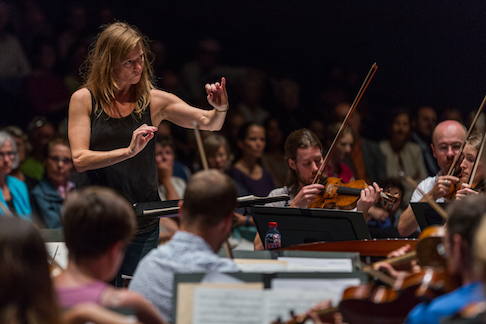
On bare feet and in jeans with a casual but focused air, the virtuosa opened with a segment from Berg’s Lulu Suite. Having sung this role often, she knows all the tone rows of Berg’s characters, thus prepared to conduct this piece with dramatic perspective, but She did not sing. Instead she demonstrated her conducting skills were not just a gimmick and revealed an authentic talent. As extended extremities, her sinewy, muscular yoga arms became her batons. She performed the part of the piece where Dr. Schön’s in-love son Alwa meets Lulu right after she is released out of prison. Highly dramatic and very engrossing. Berg’s feverish music fit the humid summer heat arising from the lake.
Around the same time Berg was writing Lulu, Gershwin composed Crazy Girl. Hannigan recounted how the American composer supposedly was too shy to perform his music in front of the Austrian composer at a Vienna party. To which Berg responded: “Music is music”. Bill Elliott’s orchestration of Gershwin’s songs strangely resonated Berg’s atonality. I would have never associated the two with each other, if I had not heard them in this context: Gershwin like never before. It was a pity I could not stay next evening’s official premiere of Elliott’s Berg-echoing orchestration of “I’ve Got Rhythm”, “Embraceable You”, and “But not for me”.
Hannigan has a slightly dansant conducting style, natural and in tune with the music. Nothing overtly theatrical. With her fabulous voice and North-American intonation she brought Gershwin’s character immediately to life. Her sighs gave the songs authenticity. “Mister, listen to the the rhythm of my heartbeat” she sang. How poetic as conductor!
During this rehearsal, Hannigan revealed her collaborative spirit. She frequently requested feedback from the MCO’s musicians and strategically asked the saxophonist for a crescendo so she could recognize her cue: “The problems is, I cannot look at the my score then”. Her insistence on feedback resulted in great synergy: “Can I just hear that one, but without me?”.
The big reveal in Elliot’s orchestration was the sudden choral singing of the Mahler Chamber Orchestra as back-up to the Maestra. They really seemed to enjoy this part. Certainly an unforgettable rehearsal.
I highly recommend the intimate setting of the 40 min. series. A terrific place to bring small children.
David Pinedo
image=http://www.operatoday.com/160822_40min4_mco_hannigan_c_patrick_huerlimann_lucerne_festival_4.png image_description=Barbara Hannigan product=yes product_title=40 minutes with Barbara Hannigan...in rehearsal product_by=A review by David Pinedo product_id=Above: Barbara HanniganAugust 27, 2016
Prom 54 - Mozart's Last Year with the Budapest Festival Orchestra
Conductor Iván Fischer was having nothing to do with melancholy portentousness at this Prom with the Budapest Festival Orchestra, however, preceding the Mass’s dignity and darkness with two of the composer’s more sunny compositions from the final year of his life, 1791.
It’s not often that a double-bass player takes centre stage at the Royal Albert Hall. But, Zsolt Fejérvári - the Budapest Festival Orchestra’s principal double bass player since 1994 - found himself in just such a spotlight, alongside bass Hanno Müller-Brachmann (replacing, at short notice, the indisposed Neal Davies), before an expectant audience.
The concert aria ‘Per questa bella mano’ was probably composed for two members of Emanuel Schikaneder’s company at the Freihaus-Theater auf der Wieden in Vienna: the composer and singer Franz Xaver Gerl - who would become Mozart’s first Sarastro - and the double bass player, Friedrich Pischelberger. The text is a light-weight trifle - ‘By this beautiful hand, by these lovely eyes, I promise, my love, that I will never love another’ - but Mozart coats the fripperies with melodic sweetness and orchestral freshness.
Fejérvári exhibited a warm tone, investing the sound with vibrancy. His bowing was agile and fluent in the racing scales, while the challenging double-stopped passages were well-tuned and rich - no mean feat given that the Viennese violone for which the concert aria was written was rather different from the modern double bass, and the tuning pattern adopted by eighteenth-century virtuosi such as Pischelberger (so-called Viennese tuning, F1 -A1-D-F#-A) makes both the arpeggios built on the original natural harmonic series and the extended double stopping challenging on a modern instrument. Fejérvári inserted an idiomatic cadenza and engaged cheerily with the vocal line, as if raising a wry eyebrow at the singer’s more indulgent sentimentalities.
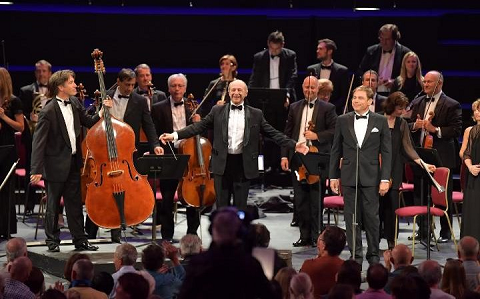 Zsolt Fejérvári (double bass) and Hanno Müller-Brachmann (bass) with Iván Fischer (conductor) and the Budapest Festival Orchestra. Photo Credit: Chris Christodoulou.
Zsolt Fejérvári (double bass) and Hanno Müller-Brachmann (bass) with Iván Fischer (conductor) and the Budapest Festival Orchestra. Photo Credit: Chris Christodoulou.
Müller-Brachmann (who has performed this concert aria recently with the BFO) had trouble settling the pitch in the opening phrases of the introductoryAndante, but later revealed a sonorous low register, if not always a full weight, and a well-rounded tone. The exuberance he brought to the Allegro revealed why his Papageno has won acclaim, and in the imperious vocal rises he demonstrated a strong, centred baritonal top. The Budapest Festival Orchestra, which Fischer co-founded in 1983 with his fellow Hungarian conductor Zoltán Kocsis, accompanied with precision and delicacy, the flute ‘duetting’ elegantly at times with the solo double bass. Fischer established a lovely lilt in the Andante, and expressive string vibrato and phrasing was complemented by lucid woodwind and honeyed horns.
The BFO were joined by clarinettist Ákos Ács, the orchestra’s principal clarinet since 1999, for Mozart’s Clarinet Concerto in A, which Ács performed on the longer, more mellow-toned basset clarinet - the instrument for which Mozart composed the concerto. The orchestral playing remained fresh and transparent of texture, and Ács’s unassuming melodiousness, supple phrasing and rhythmic buoyancy were refreshing. The sound was clean and airy, the phrasing full of grace, and Ács employed a variety of articulations, nicely contrasting flowing slurs with tripping, articulated runs. But, somehow the concerto didn’t quite sparkle. The opening of the second movement Adagio was phrased sensitively by all, but the tempo felt needlessly hurried and Ács didn’t make enough of the dynamic contrasts or fully exploit the expressive weight of the instrument’s lower register. The Rondo, Allegro began at a lick but lost momentum, and the later restatements of the theme thus didn’t invoke the joyous ebullience that they can and should. For that we had to wait for the klezmer-style encore, ‘Sholem-Alekhem, Rov Feidman’ (Peace be upon you, Rabbi Feidman), by the Hungarian clarinettist Bela Kovacs - which Ács, with the complicity of the BFO, seemed to begin in the wings and which induced faux surprise and disdain from Fischer.
In a recent interview-article in The Guardian (interview) Fischer made it clear that what he wants above all in his music-making with the BFO is to avoid a sense of routine: “We work with intensity and in a very personal way. It is more like the way a string quartet works. I don’t say to the principal cellist: ‘Please a little softer.’ I would say: ‘Come on Peter, what the hell are you doing?’ It’s a different communication, much more personal. I immediately notice when their level of focus or concentration is not what it should be. I work much more like a theatre director would work with actors.”
There was nothing at all ‘routine’ about Fischer’s reading of the Requiem: tempos, stage placements and the overall expressive sentiment were all highly individual, verging on the eccentric. Fischer’s reading was not without interest but many of his choices eventuated inherent problems that were not entirely overcome in performance.
The first note of surprise was instigated by the spatial arrangement of the musicians and singers. The 24 singers of the Collegium Vocale Gent were dispersed among the BFO players, seated at orchestral desks as if members of an instrumental section; the woodwind formed an inner circle in front of the strings, while the brass were ranged in an arc behind. Given the fairly small forces, Fischer would seem to be aiming for a seamless fusion of vocal and instrumental sound - a worthy ambition, but one which hit a few problems.
I’d be surprised if the singers could actually hear each other: each member of the Collegium Vocale Gent was essentially a soloist, or part of duo, and though the individual lines of the choral numbers were sung with beautiful tone and crisp rhythms, at times ensemble and balance were awry. It may have depended upon where one was seated in the RAH - and perhaps the effect on live radio (BBC iPlayer), aided by well-placed BBC microphones, was more effective - but for this listener the two tenors at the rear and the two sopranos at front-left were acoustically privileged. At times, the dispersion of the sound was exciting and embracing. But, some of the contrapuntal writing, especially in the opening movements, was messy, and the majestic power, and terror, of the full choral pronouncements in the Dies Irae and the Confutatis (pity the fiddles whose right arms must have almost flown out of their sockets so precipitous was Fischer’s tempo - hysterical rather than horrified - in the former) felt diluted.
The BFO principal violinist had a trying task leading an orchestra many of whose members must have had difficulty in seeing her (and perhaps in gaining a clear sight-line of Fischer himself, when the desks of singers stood for the choral numbers). Ensemble both within and between sections was poor in places, even though the orchestra was chamber-sized, and the intense focus that might be summoned from smaller forces was absent. This was a pity because it was clear that each phrase was shaped with extreme care by Fischer and that the players understood his intent: the fragmented stage-positioning meant that it was challenging for them to produce the desired effect as a synchronised ensemble.
Fischer did conjure some theatricality, without melodrama, whizzing through the movements, which often succeeded each other segue; indeed, Fischer seemed to be driving through an ‘operatic’ scenario so fast that I began to wonder if the BFO were booked on a 10.30pm flight back to Hungary. Road traffic signs warn that ‘Speed kills’: and this is a caution worth heeding. The score’s dramatic gestures did not have time to tell, dotted rhythms seemed bouncy rather tremorous with tension. I winced when we were cheated of the tender beauty of the Recordare: the initial dialogue between the cellos and clarinet was as impetuous as a 100-meters Olympic final and the singers had neither melodic breadth nor spaciousness of breath to shape the glorious layering of the vocal lines - regrettable given the apparent, though fleeting, unified blending of the quartet of solo voices.
The pervasive sobriety of the Tuba miriam was also denied us but trombonist Balázs Szakszon admirably coped with the technical challenges of performing one of the repertoire’s most well-known orchestral solos at the urgent tempo chosen by Fischer. Similarly, the soul-worrying cries, ‘Rex’, at the start of the Rex tremendae majestatis (O King of awful majesty) did not have time to register the terror that the text implies.
Then, having created seemingly unstoppable, even accelerating, momentum, Fischer slammed on the brakes before both the Offertorum and the Sanctus: the long silences implied that the Proms’ audience - perennially the most attentive and focused of listeners - was comprised of naughty children of whom absolute silence and stillness were demanded before the performance would recommence.
Fischer did find some sad delicacy in the Lacrimosa which pleasingly did not drip with sentiment: the string sighs were expressive rather than effusive, and were complemented by lovely pianissimos from the Collegium Vocale Gent, with the woodwind solos allowed to speak tellingly.
The four soloists - seated to rear, and in the midst, of the orchestra - gave performances of varying impact. Soprano Lucy Crowe tended to dominate the ensembles, but this was not her fault, her voice simply soared with wonderful clarity: her solo statements had a lofting intensity and richness which was utterly heart-winning. When I saw Barbara Kozelj sing with the Academy of Ancient Music at the Barbican Hall last October, in Monteverdi’s Il ritorno d’Ulisse in patria (review), I commented that the mezzo-soprano’s Penelope was a ‘still oasis of stoical forbearance’; and Kozelj didn’t seem any more inclined to join in the breakneck haste here. She shaped her solo and ensemble contributions with chastening elegance and restraint, and her tone had a soulful focus which Fischer was not disposed to indulge.
Müller-Brachmann was again resonant but the intonation problems which tempered his earlier aria reappeared at the start of the Tuba miriam; tenor Jeremy Ovenden was at home with the prevalent theatrical urgency but his tone was occasionally protrusive in the ensembles.
I’m not averse to innovation and a fresh look at familiar musical friends. But, there are some works of art that don’t need to be tinkered with, especially if nothing new is revealed.
Claire Seymour
Prom 54 - Mozart: Aria ‘Per questa bella mano’ K.612, Clarinet Concerto in A major K.622, Requiem in D minor K.626 (compl. Süssmayr).
Lucy Crowe (soprano), Barbara Kozelj (mezzo-soprano), Jeremy Ovenden (tenor), Hanno Müller-Brachmann (bass), Ákos Ács (clarinet), Zsolt Fejérvári (double bass), Iván Fischer (conductor), Budapest Festival Orchestra, Collegium Vocale Gent.
Royal Albert Hall, London; Friday 26th August 2016.
image=http://www.operatoday.com/Prom%2054%20Budapest%20Festival%20Orchestra%20Fischer.png image_description=Prom 54, Budapest Festival Orchestra conducted by Iván Fischer product=yes product_title= Prom 54, Budapest Festival Orchestra conducted by Iván Fischer product_by=A review by Claire Seymour product_id=Above: Iván Fischer conducting the Budapest Festival Orchestra and Collegium Vocale Gent.Photo credit: Chris Christodoulou.
August 26, 2016
High Voltage Tosca in Cologne
This dramatic production engaged with fine vocals and an exhilarating choir. With his vocal gravitas, Samuel Youn as Scarpia dominated the stage. The Te Deum made for one of the more epically scaled opera scenes I witnessed this season. The director moved the opera from Puccini’s originally intended 1800 to the end of WW II in fascist Italy. It wasn’t too farfetched after Lucia yesterday, so I didn’t mind. The idea of history repeating seemed acceptable.
While the audience sits down, the priest is already preparing mass. Choir members pray in the pews. Thilo Reinhardt’s staging already invites intimate audience involvement. Bombs drop and explode around the church. Once in awhile the stage would reverberate. Luke Stoker carried the role of Catholic priest here with conviction and his singing kept me focused.
In a flashy pink dress, Ingela Brimberg as Floria had a highly charged voice and the required dramatic flair to enrich the thespian nature of her character. Her vibrant voice phrased her passage with great urgency. In “Vissi d’arte” she reached all her notes resonantly. Her voice went the distance. Disappointing chemistry with Lance Ryan’s Mario made their scenes only mildly sensual, especially in their love duet “Qual'occhio”.
Ms. Brimberg cast a bit of a shadow with her ardor. I expected Mr. Ryan to give back more. I did not get carried away by his “Recondita armonia”. In his interactions with Angelotti, he was also overshadowed by the revolutionary zeal in Lucas Singer’s engrossing voice. Still, I was quite taken by Mr. Ryan’s “E lucevan le stelle” in Act III. His drama skills convinced.
The star of the evening, Youn intimidated as his powerfully authoritarian Scarpia commanded the stage. His voice resonated with grounding depth with a devious, even bitter, character. He made this role his own. The opera is worth seeing just for him and that marvelous Te Deum with banners and inflamed torches held by the superlative choir. A truly exhilarating climax to Act I amplified by the contrast with the preceding intimacy.
Claude Schnitzler made the Gurzenich Orchester Koln have moments of brilliance with colorful woodwinds. The strings carried a great depth. He propelled Puccini’s musical momentum forward as the singers kept firing up their voices. Schnitzler balanced all the dynamic vocal forces bringing out all the violence, power, and passion in the Italian composer’s score.
The Chor of Oper Koln enriched the staging with an impressive sonority dosed with a surging energy. Reinhardt’s incorporation of the individual singers proved highly effective. Exhilarating to hear the choir’s members engage so vigorously. They brought grandeur to this production. The vocal intensity invigorated Paul Zoller’s simple set, meant to elevate the vocal drama.
It was remarkable to see two similarly dislocated productions, one over the top and uneven; the other properly balanced and vocally superb. Oper Koln’s Tosca captivates and leaves an epic impression. Even though it is not set in the time that Puccini ascribed, this Tosca hit her notes very high.
David Pinedo
image=http://www.operatoday.com/Tosca_Cologne.png image_description=Ingela Brimberg as Tosca and Lance Ryan as Cavaradossi [Photo © Klaus Lefebvre] product=yes product_title=High Voltage Tosca in Cologne product_by=A review by David Pinedo product_id=Above: Ingela Brimberg as Tosca and Lance Ryan as Cavaradossi [Photo © Klaus Lefebvre]August 22, 2016
Haitink at the Lucerne Festival
So it was with great expectations that I came to hear him perform with the Lucerne Festival Orchestra and its assembly of superb musicians. However, after tonight’s performance it became clear, that the octogenarian conductor has lost much of his vigor and grip. Haitink’s masterful technique to sustaining suspense from beginning to end lacked, resulting in more than a few moments of monotony. Still, this is Bernard Haitink! So even if he is not performing as he used to, he is still more awesome than most conductors. The performance included several exhilarating, hair raising passages.
In the opening Allegro moderato, Haitink generated a thick, rich sound from the strings that he never let go. Lucas Macias Navarro (Assistant Conductor, Orchestre de Paris), a former soloist at the Royal Concertgebouw, where he has performed under Haitink, made his oboe passages sound ever so delicate against the backdrop of this lush texture.
In between Bruckner’s lengthy movements, Haitink was able to take a moment on the chair behind him to regenerate. The Scherzo was full of buoyant optimism. The flute solos by Chiara Tonelli (from the Mahler Chamber Orchestra) enjoyed vibrancy. Raymond Curfs (Bavarian Radio Symphony Orchestra) made his timpani roar, though Haitink made sure never too loudly. In the Trio, the Dutch conductor, and longtime citizen of Lucerne, kept a steady tension going.The elegance of the dreamy harp (a rare usage by Bruckner) contrasted sharply with the horns and trumpets. Slowly and deliberately with minimal direction, Haitink brought to life Bruckner’s heft.
In the third movement, the symphony lost its intensity. Haitink used to be a master at Bruckner’s and Mahler’s Feierlich passages. He would generate and sustain a slow burning suspense throughout an entire symphony, but here is grip was missing. The person next to me let out a deep, seemingly impatient, sigh--the third movement did feel a bit tiresome. On the other hand, the chemistry between oboist and flautist produced playful contrasts in their duets.
The energetic surge at the beginning of the final movement woke up the audience again. Thrillingly bellicose sounded the triumphing Brass. The Wagner tubas added to their glow. The dark timbres of the bassoons offered their distinct shades. Haitink’s minimal conducting here generated an awesome intensity that made for a stupendous finale. He intended to elongate the delicate tension after the last note of the symphony, but an eager audience broke the silence too soon and erupted in a feverish ovation.
David Pinedo
image=http://www.operatoday.com/Haitink_Lucerne.png image_description=Bernard Haitink [Photo by Peter Fischli/Lucerne Festival] product=yes product_title=Haitink at the Lucerne Festival product_by=A review by David Pinedo product_id=Above: Bernard Haitink [Photo by Peter Fischli/Lucerne Festival]BBC Prom 45 - Janáček: The Makropulos Affair
For Emilia Marty is much more than a diva. She's the embodiment of a universal life force that transcends time and place. Emilia Marty is one of Janáček's
Dangerous Women (read more here) who live life to the full
and change those around them, and who symbolize freedom. Yet, ultimately, freedom comes at a price.
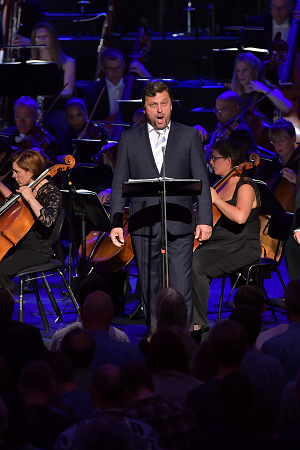 Bass-baritone Gustáv Beláček (Dr Kolenatý) at the BBC Proms 2016. Photo credit: Chris Christodoulou
Bass-baritone Gustáv Beláček (Dr Kolenatý) at the BBC Proms 2016. Photo credit: Chris Christodoulou
The Overture opens like an expansive panorama. Belohlávek's generous style suggested warm, glowing colours, adding richness to Janáček's energetic rhythms,
underlining the contrast with the claustrophobic litigation that's drained the Prus and Gregor clans for centuries. Tense, jerky figures in the orchestra.
The lines of Dr Kolenatý (Gustáv Beláček) are long and ponderous; Mattila's timbre is lustrous, but she's astute enough to make Emilia Marty's short, sharp
lines bristle, but suddenly softens gently. She knows more about the forebears of Albert Gregor (Aleš Briscein) than he does. Mattila's emotional range is
as extensive as her vocal range: her singing was extraordinarily subtle. In the Second Act, Mattila manages to convey even more complex feelings. She's
tender towards Baron Prus (Svatopluk Sem) and his son Janek (Aleš Vorácek). She understands what Emilia Marty must have felt when she sees how Kristina
(Eva Šterbová), the aspiring young singer, fancies Janek. But there's still something in EM that drives men mad. "Ha ha ha", she laughs, as if she didn't
care.
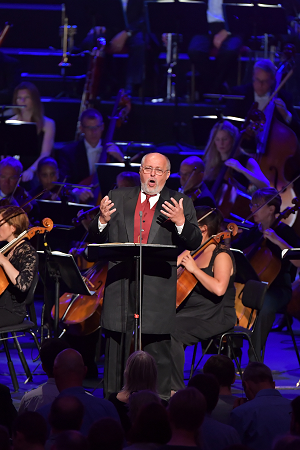 Tenor Jan Ježek as Count Hauk-Šendorf at the BBC Proms 2016. Photo credit: Chris Christodoulou
Tenor Jan Ježek as Count Hauk-Šendorf at the BBC Proms 2016. Photo credit: Chris Christodoulou
The point cannot have been lost on Janáček himself. whose best years came late. Significantly, Count Hauk-Šendorf (Jan Ježek) is written for the same Fach
as the protagonist in The Diary of One who Disappeared, which marked the composer's true creative breakthrough. Hauk thinks Emilia Marty is the
girl he loved 50 years before, a gypsy, an outsider beyond the pale of polite society. "I left everything behind, everything with her". The song cycle, the
opera and the composer's private life are thus linked. Kamila Stösslová, Janáček's muse but not mistress, was also a "chula negra" (a dusky beauty). Hauk
sings "It's an ugly business, being old" and wants to run off to Spain with Emilia, since making love keeps you young. Emilia packs her bags, but Hauk's
doctor intervenes. Hauk's been insane since he lost his gypsy. Like Emilia, he laughs in hollow, mechanical tones, more tragic than funny.
This throws sinister light on the scene in which EM reveals her past, as Elian Macgregor, as Eugenia Montez, as Ekaterina Myshkin and as Elina Makropulos,
whose father invented the potion that's kept her young for 337 years. That's the "Věc Makropulos", the formula that disrupts the natural cycle of life. The
opera ends with a kind of Mad Scene, where Janáček's music explodes into manic, yet oddly logical frenzy. To EM, the explanation makes perfect sense.
Trumpets blare, the tuba howls, the strings whizz like demons. Emilia blasphemes. "You believe in humanity, in greatness, in love!", she sings, "There's
nothing more we could wish for!". A small chorus (the men of the BBC Singers) appeared, singing responses in a parody of a Mass. Mattila's too good to
screech but manages to show how EM unwinds, like a broken toy. She wants Kristina to take the formula, and be famous. But Kristina is much too down to
earth to fall for it.
Jirí Belohlávek was Chief Conductor of the BBC Symphony Orchestra for many years, concurrently with his role as Chief of the Czech Philharmonic Orchestra, which he brought to London earlier this year for Janáček Jenůfa. (Read my review here.)
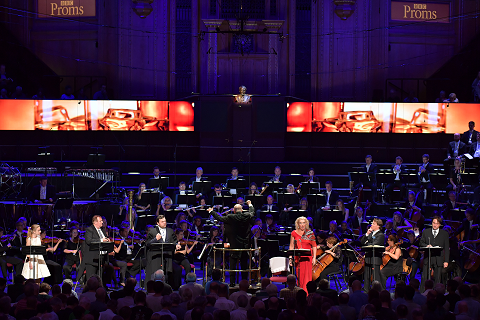 (L-R) Eva Štĕrbová, Jan Vacík, Gustáv Beláček, Kartia Mattila, Aleš Briscein and Svatopluk Sem perform under the direction of Jiří Bĕlohlávek at the BBC Proms 2016. Photo credit: Chris Christodoulou
(L-R) Eva Štĕrbová, Jan Vacík, Gustáv Beláček, Kartia Mattila, Aleš Briscein and Svatopluk Sem perform under the direction of Jiří Bĕlohlávek at the BBC Proms 2016. Photo credit: Chris Christodoulou
The BBC SO rose to the
occasion for this Prom, welcoming Belohlávek with wonderfully lively playing. They learned much in their "Belohlávek Years" and haven't forgotten. His
rapport with his singers and players was almost palpable. None of us will make age 337, but the message, as such, is not so much how long you live but how
well you live. As Janáček wrote to Stösslová, after attending the Karel Čapek play on which the opera is based, "We are happy because we know that our life
isn't long. So it's necessary to make use of every moment, to use it properly". Belohlávek is looking frail these days, though his conducting is still full
of fire. As I watched, I thought how wonderful it was to be able to hear him again. I hope he realizes how much he's appreciated!
Anne Ozorio
BBC Prom 45 - Leoš Janáček: The Makropulos Affair (Věc Makropulos)
Emilia Marty, Karita Mattila (soprano); Albert Gregor, Aleš Briscein (tenor); Dr Kolenatý, Gustáv Belácek (bass-baritone); Vítek, Jan Vacík (tenor); Kristina, Vitek's daughter, Eva Šterbová (soprano); Baron Jaroslav Prus, Svatopluk Sem (baritone); Janek, Aleš Vorácek (tenor); Count Hauk-Šendorf, Jan Ježek (tenor); Stage Technician, Jiri Klecker (baritone); Cleaning Woman, Yvona Škvárová (contralto); Chambermaid, Jana Hrochová-Wallingerová (contralto); Jirí Belohlávek, conductor; Kenneth Richardson, stage director; BBC Singers (men's voices), BBC Symphony Orchestra.
Royal Albert Hall, London, 19th August 2016.
Photo credit: Chris Christodoulou
August 21, 2016
Two Tales of Offenbach: Opera della Luna at Wilton's Music Hall
And, where better to perform these exuberant burlesques than Wilton’s Music Hall - the earliest surviving Grand Music Hall, set in the historic East End of London.
Founded by Clarke in 1994, Opera della Luna has garnered well-deserved praise for its zany, zippy productions of operatta, comic opera and pantomime. Its touring productions might notionally be ‘small-scale’ - performed by a troupe of actor-singers, without chorus, and accompanied by a small orchestral ensemble - but there’s nothing ‘miniature’ about their ambition or their theatrical impact.
Charmed as we are by Offenbach’s full-scale operatic gems - such Les Contes d'Hoffmann, Orphée aux enfers and La vie parisienne - we often forget that he was the composer of some 90 operettas, more than 50 of which comprise just a single act. Sometimes employing a full cast and chorus, elsewhere just two singers, they ranged from brief curtain-raisers to hour-long works, and reveal Offenbach’s delight in farce, fantasy, cloak-and-dagger melodrama and the exotic.
Having striven in vain to get his work performed at the Opéra-Comique and other lyric theatres in Paris, in 1855 at the age of 35, Offenbach obtained a license to open a small wooden theatre in the Champs Elysees - the Théâtre des Bouffes-Parisiens - for the performance of one-act pieces typically comprising a brief orchestral prelude followed by half-dozen or so solos and duets.
Railing against the dull pretentiousness of the operatic fare on offer at the Opéra-Comique, Offenbach promoted the tiny new theatre which had lain empty between two trees on the Champs-Élysées, declaring: ‘In an opera which lasts only three quarters of an hour, in which only four characters are allowed and an orchestra of at most thirty persons is employed, one must have ideas and tunes that are as genuine as hard cash.’ The same might be said of a modern-day independent opera company - particularly in the absence of much ‘hard cash’ in the form of government support for artistic innovation and accomplishment.
Fortunately, Clarke is a cornucopia of ideas and theatrical masterstrokes. These two productions overflow with a glut of side-splitting gimmicks and gags. The guffaws came thick and fast from the first, and did not stop. Clarke appreciates the affection with which Offenbach lays bare human eccentricities, delusions and shortcomings. And, with a knowing nudge-wink which steers just the right side of vulgarity and excess, the director shows that he is genuinely fond of these preposterous characters while at the same time nailing their bizarre flaws and foibles.
Croquefer lampoons the violent immorality of the Crusades and sends up the arrogant affectations of medieval knighthood. Croquefer, ‘an immodest and faithless knight’, has imprisoned Peasblossom, the daughter of his arch-enemy, Rattlebone. Their enmity has lasted for 23 years, financially ruining Croquefer and depriving Rattlebone of arm, leg and tongue. Yet the latter remains a formidable, fear-inducing opponent, and Croquefer swallows his last weapon, his beloved sword of Toledo, willing to accept an inglorious peace.
He orders his nephew, Headstrong, to guard their hostage. From her cell, Peasblossom recognises her guard as her beloved, and in their ensuing love-duet they dream of running off together to Paris, imagining the delights they will enjoy at the Opéra. When Rattlebone arrives, Croquefer gives him a choice: either he must permit Peasblossom to become Croquefer’s wife, or she will be killed. To evade this fate, Peasblossom and her amour poison the wine and plot to murder the two adversaries, who are preparing to do battle. As the duel commences, the spiked drinks take effect and the sword-play is interrupted for a swift dash to the thrones-turned-commodes. The violent purgation returns both Croquefer’s sword and Rattlebone’s tongue to their owners. Differences are settled, Croquefer begs the audience’s indulgence - and the composer and librettist of the piece (or in this case, conductor Toby Purser) are dragged off to the asylum!
The exposed bricks of Wilton’s, shrouded in wafting smoke, were a fitting back-drop for Croquefer’s dilapidated black tower which thrust up into a storm-cloud strewn sky. Elroy Ashmore’s economical set designs had a Gothic edge - the arms of Croquefer’s throne curling out like grotesque hands - which was complemented by Nic Holdridge’s bold lighting design.
Attired in leather breeches and sporting straggly black locks, Carl Sanderson made an immediate impression as the eponymous villain - self-important, blustering and snarling, and equipt with a powerful tenor with which to lament the disintegration of his once-modish castle. He was aided with apt ineptitude by Caroline Kennedy’s goofy Fireball - a cross-between the Artful Dodger and a circus clown. Eager to please, Kennedy shone with feverish excitement as she peered through her telescope at the advancing Rattlebone, or lined up model Crusaders to imitate the beleaguered Croquefer’s diminished army. The role of Fireball was originally composed for tenor, but Kennedy’s bright, sweet-toned soprano added freshness and air to the macho mix, especially in the spirited Trio in which Headstrong’s eagerness for combat encourages Croquefer to renew his struggle against his foe.
Anthony Flaum’s lovely lyric tenor blended melodiously with Lynsey Docherty’s ingénue Peasblossom in their mock-dramatic love duet, as they scaled the parodic heights of Offenbach’s comedic quotations from the hits of the day: Jacques Halévy’s La Juive and Giacomo Meyerbeer’s Robert le Diable and Les Huguenots.
Offenbach and his librettists cocked-a-snook at the Parisian authorities, evading the regulation forbidding more than four characters to appear on stage at the Théâtre des Bouffes-Parisiens, by making their fifth character a mute who has sacrificed his tongue in his battles with the Saracens, and whose contribution to the final quintet is limited to grunts and howls. One-armed and one-legged, Paul Featherstone staggered valiantly and lop-sidedly on crutches, worn down by his over-size helmet and basket of placards as he sought to rescue his captive daughter. He and Sanderson had plenty of fun during the pantomime-joust and sword-fights (choreography, Jenny Arnold), their perfectly timed faux-amateurism paradoxically highly polished and professional.
Known as the ‘Mozart of the Champs-Élysées’ and the ‘Napoleon of the operetta’ - and living in Paris under Napoleon III, a time when few in society, from high to low, were really what they claimed to be - in some ways Offenbach’s whole life was a mask-wearing charade, and it’s no surprise that so many of his characters do nothing but pretend to be what they are not. Offenbach’s The Isle of Tulipatan takes this role-playing to a new level of Wildean absurdity. A double-en travesti farce of identity-crisis and quid pro quo, in which Nature triumphs over human presumption and foolishness, this ‘bouffonerie’ takes place ‘at 25,000 kilometres from Nanterre, 473 years before the invention of the chamber pot’.
On the island of Tulipatan, King Cacatois XXII is unaware that his only son, Alexis - whose gentle disposition dismays him - is in fact biologically, his daughter, disguised as such by his wife who refused to have another attempt at producing the heir to the throne so craved for by her husband. Coincidentally, in order to avoid her child being conscripted into the army, Theodorine, the wife of the Duke’s steward, Field Marshall Rhomboid, has also deceived her husband: their daughter, Hermosa, is in fact a boy, because the anxious mother could not bear the thought of losing him to military service. Alexis and Hermosa are engaged to be married but their ignorance of their true sex spawns a string of misunderstandings until self-awakening and gender-realignment ensue, to the satisfaction of all. But, not before a multitude of farcical opportunities which neither Offenbach nor Clarke neglect to exploit to the full.
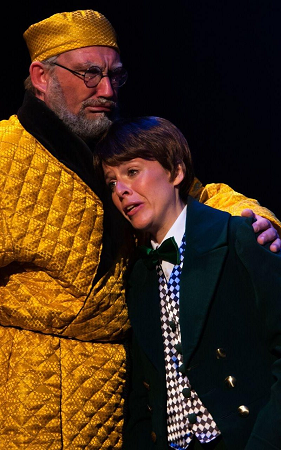 Carl Sanderson (Field Marshall Romboid) and Caroline Kennedy (Prince Alexis). Photo Credit: Jeff Clarke.
Carl Sanderson (Field Marshall Romboid) and Caroline Kennedy (Prince Alexis). Photo Credit: Jeff Clarke.
Caroline Kennedy’s emerald-frock-coated Prince Alexis delivered ‘his’ sentimental romance on the death of his pet bird with bell-like purity, touching sincerity, not a hint of mockery and just the right amount of mawkishness. After the tomfooleries of Croquefer, Kennedy really showed her dramatic range here using her voice and face most expressively. Her naïve curiosity when faced with the veracity of her femininity - ironically dressed in a green and purple gown with black Doc Martins - was heart-winning.
Costumer Isobel Fellow supplemented the absurdities of the plot with costumes of garish complementary hue and Hermosa’s lurid pink frock with zebra accessories made for a wonderfully incongruous clash with the swaggering sentiments of Hermosa’s military song. This was a terrific performance from Flaum who, in drag, seemed to have taken inspiration from the late Les Dawson’s pantomime-dame arm-folding, hand-bag clutching and gurning grimaces.
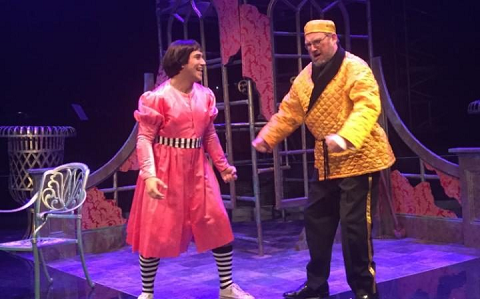 Anthony Flaum (Hermosa) and Carl Sanderson (Field Marshall Romboid). Photo Credit: Jeff Clarke.
Anthony Flaum (Hermosa) and Carl Sanderson (Field Marshall Romboid). Photo Credit: Jeff Clarke.
Ashmore’s crenellated tower had been stripped of its battlements to reveal the crimson and gold flock-wallpaper of Rhomboid’s shabby-chic chateaux: a fitting setting for Lynsey Docherty’s Theodorine who had clearly wandered off the set of Ab Fab and whose lugubrious inebriation would have given Edina a good run for her money. Docherty’s insouciant indifference when she sweetened the Duke’s tea with a sugar-lump salvaged from his foot-bath was priceless.
Carl Sanderson’s Field Marshall and Paul Featherstone’s Duke were once again a superb double-act: their performances were full of vitality. Featherstone minced with ludicrous pomposity, resplendent in red velvet knickerbockers and diamond-patterned stockings. This was Alice in Wonderland meets Oscar Wilde: the Knave of Hearts had somehow found himself in The Importance of Being Earnest. Featherstone may have ‘delivered’ his numbers - a political satire with animal imitations, and a tongue-in-cheek ‘bacarolle’ - rather than sung them, but that didn’t lessen their spiciness or éclat.
Offenbach’s two scores may not be sparkling with musical invention - indeed, sometimes the music seemed to play second fiddle to the farcical comedy - but the composer had an innate flair for heightening theatrical comedy with a catchy tune and a touch of musical twinkle, and the nine instrumentalists played the score with evident enjoyment and vibrancy. Purser kept things whipping along, but judiciously allowed the cast to make the comic moments tell.
In any case, Clarke’s playful improprieties and droll rhyming couplets could turn even the most mundane melody into a memorable ear-tickler: “So here’s a happy ending to our curious farce/ A tale of gender-bending in the upper class.” In this delicious double-bill, Clarke entwined madness and merriment, and coated both with tenderness: quite simply, irresistible.
Claire Seymour
Jacques Offenbach: Croquefer, or The Last of the Paladins (1857)
Libretto: Adolphe Jaime and Etienne Trefeu
New English Version: Jeff Clarke - first performance July 23 2016
First performance: Theatre des Bouffes-Parisiens, February 12, 1857
Croquefer, Carl Sanderson; Fireball (Boutefeu), Caroline Kennedy; Headstrong (Ramasse-ta-Tête), Anthony Flaum; Rattlebone (Mousse-à-Mort), Paul Featherstone; Peasblossom, (Fleur-de-Soufre), Lynsey Docherty.
Jacques Offenbach:
The Isle of Tulipatan
Libretto: Henri Chivot and Alfred Duru
New English Version: Jeff Clarke - first performance July 23 2016
First performance: Theatre des Bouffes-Parisiens September 13 1868
Cacatois XXII, Duke of Tulipatan, Paul Featherstone; Prince Alexis, his son, Caroline Kennedy; Field Marshall Rhomboid, Carl Sanderson; Theodorine, his wife, Lynsey Docherty; Hermosa, his daughter, Anthony Flaum.
Director, Jeff Clarke; Conductor, Toby Purser; Set Designer, Elroy Ashmore; Costume Designer, Isobel Pellow; Lighting Designer, Nic Holdridge; Choreographer, Jenny Arnold; Orchestra of Opera della Luna.
Wilton’s Music Hall, London; Friday 19th August 2016.
image=http://www.operatoday.com/Anthony%20Flaum%20%28Headstrong%29%20and%20Caroline%20Kennedy%20%28Fireball%29.png image_description=Opera della Luna at Wilton’s Music Hall product=yes product_title=Opera della Luna at Wilton’s Music Hall product_by=A review by Claire Seymour product_id=Above: Anthony Flaum (Headstong) and Caroline Kennedy (Fireball)Photo credit: Jeff Clarke.
August 19, 2016
Britten Untamed! Glyndebourne: A Midsummer Night's Dream
The First Act takes place in dense forest, at night, when nothing is as it might seem. Do we see trees or projections thereof, or both? What do the shadows
conceal, even when the moon slips fleetingly through clouds? John Bury's designs are immortal because they are so abstract, and surprisingly ‘modern’,
though they ostensibly resemble the well-known Victorian painting by John Noel Paton - another reversal of visual imagery. Since Shakespeare's A Midsummer Night's Dream operates on so many simultaneous levels, the one thing to be wary of is literal realism.
How Britten must have relished the opportunities to express in music what could not be said in words. Like Shakespeare, Britten was poking fun at a world
that mistakes power for virtue and convention for truth. Theseus and Hippolyta - ancient Greeks in Elizabethan costume - sneer at the Mechanical's play.
But perhaps the joke is on them. A Bergomask before bedtime might just have unforeseen consequences. Britten's Gloriana was long misunderstood by
audiences who took it at face value. A Midsummer Night’s Dream, written barely seven years later, has an infinitely superior plot and the music is
much more sophisticated, but there are parallels. And in A Midsummer Night's Dream there are levels which would have had personal resonance for
the composer.
Jakub Hrůša's conducting is so idiomatic that we can almost feel the caustic bite of Britten's humour, while also feeling the pain that lies beneath the
surface. Britten's score sparkles with variety. Figures shape shift as swiftly as they are delineated, Elizabethan forms pop up from the endlessly elusive
and very contemporary stream of consciousness. Hrůša doesn't smooth over the spikiness, but keeps the pace animated, so the orchestral playing seems to fly
free, like the Fairies - the Elementals to the earthbound Mechanicals. The moments of reverie glowed, the lower woodwinds and brass breathing ominous
mystery. The London Philharmonic Orchestra seemed to shine for Hrůša, even more than they usually do. Perhaps Hrůša brought insight from having conductedRusalka and The Cunning Little Vixen at Glyndebourne in the past, two operas which also have close affinity with A Midsummer Night's Dream. Hrůša seems to intuit how pertinent the variety in the score is to the meaning of the opera. Everything changes at the
turn of a point, themes transform, like magic, nothing can be taken for granted. Because Hrůša got such alert, taut playing from the orchestra, he could
bring out the innate anarchy beneath Britten's elegantly defined orchestration. Orchestrally, this was an exceptionally vivid performance, so strong that
it will live in the memory.
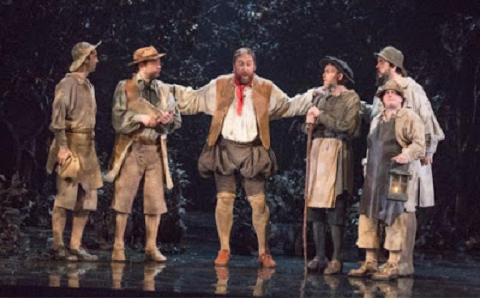 Matthew Rose (centre) as Bottom, with the Mechanicals. Photo credit: Robert Workman.
Matthew Rose (centre) as Bottom, with the Mechanicals. Photo credit: Robert Workman.
The cast, acting as well as singing, were of an equally high order. Matthew Rose first sang Bottom ten years ago. Now, he's matured and so has his characterization of the part, which will probably now be hard for anyone else to improve upon. Bottom is Everyman but no fool. Rose's voice carries authority, which is why his friends turn to him as leader. Even with the head of an ass, and his bottom in the air, Rose makes the part dignified and sympathetic. Rose makes the ‘donkey’ wheeze in Bottom's lines sound so natural that, even in the palace in the final Act, a bit of donkey-ese breaks through irreverently. Even his body movements worked in synch. Equally strongly cast were the
Mechanicals - David Soar (Quince), Sion Goronwy (Snug), William Dazeley (Starveling), Anthony Gregory (Flute) and Colin Judson (Snout). In ensemble, they
were superb, singing and speaking as if to the manner born. In the play, and in the opera they are much more significant than Theseus (Michael Sumuel) and
Hippolyta (Claudia Huckle).
As Oberon, Tim Mead's high, sharp timbre dripping malevolence, reversing the more usual baroque stereotype of counter tenor as hero. He towered over
Kathleen Kim, as Tytania. Good visual casting, reflecting the power play between them. Kim, though, was no submissive. She sang forcefully and with élan -
no surprise that she's a Glyndebourne favourite. Oberon's hair was styled in two peaks, resembling the ears of an ass. Wonderfully subtle touch. The
lovers, Lysander (Benjamin Hulett), Hermia (Elisabeth DeShong), Helena (Kate Royal) and Demetrius (Duncan Rock) were also well cast, DeShong creating
Hermia's feisty, strong-willed personality with particular definition.
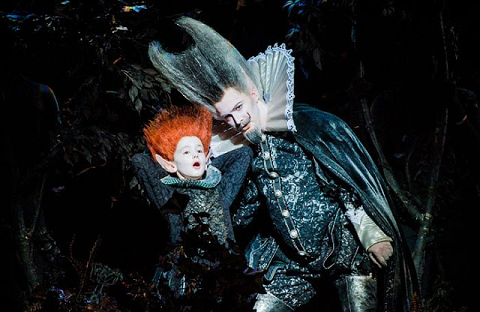 David Evans (Puck) and Tim Mead (Oberon). Photo credit: Robert Workman.
David Evans (Puck) and Tim Mead (Oberon). Photo credit: Robert Workman.
But Puck is the agent of insurrection, upon which the plot turns, and particularly symbolic for Britten himself. Puck is not a singing part, but David
Evans stole the show, quite an achievement for an actor stepping in at short notice, into a part that's so demanding that it's notoriously difficult to
cast. Britten dreamed that it could be played by a young athlete whose voice was beginning to break: a changeling between two worlds, a Britten innocent on
the cusp of corruption. Tadzio, with a voice. And what a voice! Evans is cheeky and shrill like a boy, yet also rebellious and assertive like someone
passing into his teens, though he looks younger. He also projects with great force, while respecting the curious rhythm in the text. Evans runs up and down
stage, sailing into space on a guy rope, popping in and out of the scenery, without missing a note. Did Britten identify with Puck, who could get away with
things a nice, obedient boy like Young Ben could not? And yet Puck is a tragic figure, not so much because he doesn't belong but because his freedom cannot
last. Will he be sucked into Oberon's sick games? Evans will grow up, but this moment of glory will live with him for the rest of his life.
Catch this Glyndebourne A Midsummer Night's Dream.
Anne Ozorio
Britten: A Midsummer Night’s Dream
Theseus (Michael Sumuel), Hippolyta (Claudia Huckle), Tim Mead (Oberon), Kathleen Kim (Tytania), David Evans (Puck), Benjamin Hulett (Lysander), Elisabeth DeShong (Hermia), Kate Royal (Helena) and Duncan Rock (Demetrius), Matthew Rose (Bottom), David Soar (Quince), Sion Goronwy (Snug), William Dazeley (Starveling), Anthony Gregory (Flute) and Colin Judson (Snout); Director, Peter Hall; Conductor, Jakub Hrůša, Designer, John Bury; London Philharmonic Orchestra.
Glyndebourne Festival Opera; August 16, 2016
image=http://www.operatoday.com/Bottom%20and%20Tytania%20.png image_description=Glyndebourne Festival Opera: A Midsummer Night’s Dream product=yes product_title= Glyndebourne Festival Opera: A Midsummer Night’s Dream product_by=A review by Anne Ozorio product_id=Above: Matthew Rose as Bottom, Kathleen Kim as TytaniaPhoto credit: Robert Workman, Glyndebourne Festival Opera
August 18, 2016
Salzburg encores
Opera in concert is a tradition at the Salzburg Festival. The format of such endeavors is however puzzling, at least based on the concert performances (three) of Manon Lescaut in early August. Basic expectations of such events might assume that musical values would be paramount since there would not be the distraction of staging. This was not the case of this Manon Lescaut.
Instead it was a showcase for Anna Netrebko, and that alone of course validates the programming. However such a centerpiece could surely give incentive to the festival to build a cast around such vocal splendor that might strive toward some degree of high, finished art.
The assembled cast included Algerian born, Moscow trained, Franco-Corelli-finished tenor Yusif Eyvazov as Des Grieux (who happens to be Mme. Netrebko’s husband), and Mexican baritone Armando Piña as Manon’s brother Lescaut. Piña, a fine young singer, is a Resident Artist, i.e. student at Philadelphia’s prestigious finishing school for opera singers, the Academy of Vocal Arts. Geronte was sung by 66 year-old bass-baritone Carlos Chausson who has made a distinguished career singing the repertory’s well-known buffo roles.
Rather than the singers sitting in chairs with music stands and scores while waiting their turn to sing the Salzburg concert format elicits actual staging, if minimal. Singers entered and exited much as staging instruction in the score might tell them. Roles were acted, singers moved as if staged. It did not arrive at what the French call a mise en espace (there was no lighting or costumes) nor was it a concert.
The staging, probably improvised by the singers, was on the stage apron therefore the conductor, Marco Armiliato and the Munich Rundfunkorchester were behind the singers. Mo. Armiliato had no visual contact with the singers, nor did the singers ever communicate with him. Apparently at ease with standard Manon Lescaut routine this maestro never felt the need even to look over his shoulder.
Forty-five year old Anna Netrebko, in good physical and perfect vocal shape, appeared in a huge black gown discretely studded with black sequins, i.e. concert dress that made her entrances and a few hurried exits cumbersome indeed. Mr. Eyvazov wore some sort of ethnic coat of maybe Slavic, maybe Turkic inspiration that indeed set him apart, the balance of the performers wore formal concert dress.
Portraying a teenage girl was of course out of the question for Mme. Netrebko under the circumstances, and she did not really shine as an artist until Manon’s death. It was spellbinding. Though of course she was a star the entire evening and that is why we were there. Mr. Eyvazoy delivered the first act deploying the tenorial vocal and histrionic attitudes that are long out of fashion, the stuff of caricature. He rose valiantly and with a degree of artistic honesty to the occasion of Manon’s deportation — well rewarded by applause. Without proper costuming and wig Mr. Piña’s well coached singing disappeared into little more than a reading of the role to support the exploits of the tenor and soprano. In the midst of these two powerful, youthful male voices Mr. Chausson’s performance seemed small indeed. The only performance of the evening that seemed appropriate for what a Salzburg Festival concert opera might be was that of the Dance Master, fancily performed by young German tenor Patrick Vogel.
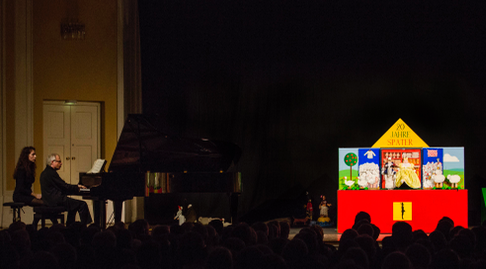 András Schiff and page turner with set for Children's Corner puppet ballet
András Schiff and page turner with set for Children's Corner puppet ballet
Hungarian pianist András Schiff, one of the world’s established concert artists, slickly played Robert Schumann’s youthful Papillons (Op. 2) of about 16 minute duration, and then played Claude Debussy’s Children’s Corner, a suite of about 17 minutes duration that Debussy composed for a piano teaching method book. For this piece Mr. Schiff used the music. Both pieces are well within the reach of advanced piano students. Surely I am not alone in wishing Mr. Schiff’s program had been from the major, virtuoso repertory.
The piano was then pushed to one side exposing puppet show contraptions. Mr. Schiff returned to perform the same two pieces, accompanying a mise en scène for each, executed by four puppeteers operating a variety of puppets.
For the Schumann’s Papillons there were characters of the novel Flegeljahre (Adolescent Years) by a writer named “Jean-Paul,” this novel the inspiration for these 12 brief pieces. Essentially the well-organized Walt wins the girl, having competed with his impetuous brother Vult for her attentions. This mise en scène was imagined by puppeteer Thomas Reichert. It was premiered in 2014 in Calgary, Canada.
Debussy amplified his Children’s Corner suite for piano into a full-scale puppet ballet for children with orchestra, La Boite à joujoux. The ballet was recast in 2010 in Ittigen, Switzerland by puppeteer Hinrich Horstkotte to fit Debussy’s original Children’s Corner for piano. The characters are Pulcinella, Golliwog — a late nineteenth century black faced puppet, evidently not a politically incorrect issue in Austria — for Debussy’s famed Golliwog’s Cakewalk, and a Soldier, plus lots of mechanical intervention of the toy box set contraption and dramatic participation by the four, obviously accomplished, black dressed puppeteers.
The evening was appreciated by the audience who apparently did not care that it was gratuitous use of the talents of Andràs Schiff.
Michael Milenski
image=http://www.operatoday.com/Salzburg_Salzburg1.png
product=yes
product_title=Encores in Salzburg
product_by=A review by Michael Milenski
product_id=Above: Anna Netrebko as Manon, Yusif Eyvazov as Des Grieux [All photos copyright Marco Borrelli courtesy of the Salzburg Festival]
August 17, 2016
Leah Crocetto at Santa Fe
Since Crocetto had a major success as Anna in Rossini’s Maometto II in 2012, she opened the recital with an aria from that composer's Semiramide, a tour de force for both singer and pianist. Rossini wrote Semiramide for his wife, Isabella Colbran, who was known for her accurate dramatic coloratura. “Bel raggio lusinghier” is the opera’s major aria and in Santa Fe both artists performed it with exquisite articulation.
I wonder if these artists knew that Angela Meade had sung the same three Richard Strauss songs, Zueignung, Morgen, and Cäcilie, in the same hall a few days earlier. In any case, they are wonderful songs and both Crocetto and Meade sang them with exquisite grace. In all probability the Rachmaninov segment that included Zdes khorosho (How fair this place), Ne poy kravitsa pri mne (Don’t sing, my beauty), and Otrivok iz A. Musset (An excerpt from Alfred de Musset), brought many art song lovers to the recital. Here Crocetto proved her ability to put the text over when even the most frequent concertgoers might not know the meaning of the Russian words. Listening to her vocal colors, one could think of being in a majestic natural setting with with a lover. The message of the second song served to remind listener of past homes and the last song invited the audience to empathize with Musset’s hopeless lover.
In 1838, when Franz Liszt and Marie d’Agoult stayed in Italy they read Petrarch’s works together and the readings inspired the composition of Three Petrarch Sonnets. In Pace non trovo (I can’t find peace) the lyrics are replete with extreme contrasts, so Liszt expressed them with forward-looking harmonies and constant agitation. Crocetto and Sanikidze made the urgency of the poet’s love real to their twenty-first century audience. The second song, Benedetto sia l’giorno (Blessed be the day) was quite appropriate in this uniquely beautiful old hall far from the crowds and commercialism of a less appreciative city. Toward the end of I vidi in terra (On earth revealed), Petrarch wrote a line that describes much of this recital: “So sweet a concert made as ne’er was given mortal ear.” Crocetto’s high notes are extraordinary; her middle range is warm, and her chest tones remind the listener of singers we can now only hear on records.
For their finale, Crocetto and Sanikidze offered an aria from Carlisle Floyd’s opera Susannah: “Ain’t it a Pretty Night?” Crocetto's phrasing was regal, her diction understandable, and her tones luscious. During this selection and every other work on this program, Sanikidze partnered her with exquisite playing. Since the soprano had sung jazz earlier in her career, her encores included Jerome Kern’s All the Things You Are and “My Heart Is So Full of You” from Frank Loesser’s The Most Happy Fella.
This summer, Performance Santa Fe presented recitals by Daniel Okulitch and Keri Alkema with pianists Glen Roven and Joe Illick; Angela Meade with Illick, Leah Crocetto with Tamara Sanikidze, as well as Joshua Hopkins and Ben Bliss with Illick. We can expect them to have a similarly fine roster next season.
Maria Nockin
Program:
Rossini: Semiramide “Bel raggio lusinghier” R. Strauss: Zueignung, Morgen, Cäcilie Rachmaninov: How Fair this Place, Don’t Sing to Me, my Beauty, Why is my Sick Heart Beating so Frantically? Liszt: Three Petrach Sonnets Floyd: Susannah, “Ain’t it a Pretty Night?”
Encores:
Kern: All the Things You Are; Loesser: The Most Happy Fella, “My Heart Is So Full of You”.
Scottish Rite Center, Santa Fe; August 4, 2016.
image=http://www.operatoday.com/Crocetto%20Faye%20Fox.png image_description=Leah Crocetto at Sante Fe product=yes product_title=Leah Crocetto at Sante Fe product_by=A review by Maria Nockin product_id=Above: Leah CrocettoPhoto credit: Faye Fox.
Angela Meade at Sante Fe
Performance Santa Fe presents recitals by artists in town to perform at Santa Fe Opera. The Scottish Rite Center is a Masonic temple built in 1912 containing an intimate theater. It houses a fully outfitted stage with a painted back drop and scrims created with the kind of fine workmanship seldom seen in today’s theatrical settings. On July 31, 2016, against the ethereal beauty of this setting, soprano Angela Meade and pianist Joe Illick gave a recital offering both opera and art songs ranging in origin from early nineteenth century Europe to mid twentieth century America. Many in the audience probably remembered Meade’s recent excellent portrayal of Norma at Los Angeles Opera.
Wearing a dress with a black top and a red and black printed skirt, Meade and the black-clad Illick began their program with an emotion-filled rendition of the aria “Io son l’umile ancella” (“I am the humble servant”) from Francesco Cilea’s infrequently performed opera Adriana Lecouvreur. It showed Meade’s ability to immediately grasp the psyche of her audience in her capable hands.
They continued with three of the five songs Franz Liszt composed in the early eighteen forties to texts by Victor Hugo: Enfant, si j’étais roi (Child, if I were King), Oh, Quand je dors (Oh! When I sleep), and Comment, disaient ils (How, they asked). In the first song Meade sang a magnificent messa di voce, swelling to a fortissimo and diminishing to the finest thread of sound. A quick look at the text of Quand je dors tells the reader that it’s about dreaming of a lover. Meade and Illick’s opulent tones soon made the meaning clear. In Comment disaient ils Meade and Illick again showed the smoothness of their combined, well-nurtured lyricism. The soprano also demonstrated a full range of dynamics and the perfect trill we heard in Norma.
Angela Meade. Photo Credit: Dario Acosta.Vincenzo Bellini, the composer of Norma, wrote songs such as the familiar, melodic Vaga Luna and the less well-known but equally interesting Ma rendi pur contento. Neither song is “Casta Diva”, but Meade sang both with gorgeous tone and saved her golden age operatic ability for the next aria: “Pace, pace mio dio” from Giuseppe Verdi’s La Forza del Destino. Forza is no longer in the usual repertoire because big juicy voices like that of Zinka Milanov are hard to come by. A major opera company needs to revive Forza for Meade because she sings that aria magnificently and international audiences should be able to hear her perform it with orchestra. If there had been an intermission, I think it would have been placed at this juncture. Unfortunately, at this recital there was no chance to mingle and get acquainted with other Santa Fe concertgoers.
Meade’s singing of Marietta’s bittersweet “Glück das mir verblieb” (“Joy that remains with me”) from Erich Wolfgang Korngold’s 1920 opera Die Tote Stadt left listeners contemplating the lost loves of their own lives as the artists left the stage. Illick and Meade returned to render thoughtful interpretations of three well-known songs by Richard Strauss: Zueignung and Allerseelen from Op 10, and Cäcilie from Op. 27.
For their finale, the artists performed “Ebben? Ne andro lontana” (“Well, then? I’ll go father away”) from Alfredo Catalani’s 1892 Alpine opera that ends in an avalanche, La Wally. Actually, Catalani had written the aria as a separate work but added it to the opera before its premiere. Maria Callas made the aria famous with her recording, but Meade’s rendition showed what a more voluminous voice could do for this piece. At its end she was greeted with a huge wave of applause. When we listen to Meade, we begin to know the sound of golden age singing.
Maria Nockin
Program:
Cilea: Adriana Lecouvreur, “Io son l’umile ancella.” Liszt: Enfant, Si j’étais roi, Oh! Quand je dors, Comment disaient ils Bellini: Vaga Luna, Ma rendi pur contento Verdi: La forza del destino, “Pace, pace mio Dio.” Korngold: Die tote Stadt, "Mariettas Lied" . R. Strauss: Zueignung, Allerseelen, Cäcilie Catalani: La Wally, “Ebben? Ne andro lontana.”
Scottish Rite Center, Sante Fe; July 31, 2016.
image=http://www.operatoday.com/Angela_Meade__credit_Faye_Fox.png image_description=Angela Meade at Sante Fe product=yes product_title=Angela Meade at Sante Fe product_by=A review by Maria Nockin product_id=Above: Angela MeadePhoto credit: Faye Fox.
August 16, 2016
Turco in Italia in Pesaro
That’s Gioachino Rossini and Federico Fellini in Pesaro’s historic Teatro Rossini. Italian director Davide Livermore (that’s lee-vair-MOR-aye) unabashedly re-wrote Fellini’s Lo scieco bianco (The White Sheik) and 8 1/2 as Rossini’s Il Turco in Italia, or maybe it’s the other way around. All your favorite characters were present: the sheik himself, Guido (Marcello Mastroiani) as the film director, the whore Saraghina, the priest(s) and cardinal, the glamorous mistress(s), the bearded lady, the showgirls, and probably many more characters you and I may have forgotten since the 1960’s.
Rossini’s world became Fellini’s and Fellini’s world became Rossini’s. Prosdocimo’s play got written (with a lot of help from his actors), and Fellini’s film got made. Davide Livermore brought it all together adding the perfect physical comic schtick that matched up perfectly with the musical pace of Rossini’s masterpiece. And was funny to boot, sometimes really funny, like the mute Saraghina’s dominatrix relationship with the tenor priest Narciso.
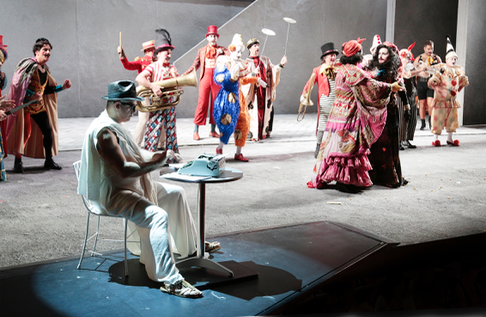 Paolo Spagnolo as Prosdocimo in Act I costume, Pietro Adaini as Albazar, Cecilia Molinari as Saida with members of the Chorus of the Teatro della Fortuna M. Agostini
Paolo Spagnolo as Prosdocimo in Act I costume, Pietro Adaini as Albazar, Cecilia Molinari as Saida with members of the Chorus of the Teatro della Fortuna M. Agostini
Surprisingly all this was not too much, given that Rossini’s librettist Felice Romani had already complicated a really simple comic situation with an absurdist pre-Pirandello intuition, like the metatheatrical Six Charactors. Just as Fellini’s films are laden with images that abstractly create a real world that is imaginary so does Livermore’s opera, a world that we feel and understand but that would take volumes to define. Finally Livermore lays out Rossini’s mixture of error and truth in the same way as had Fellini.
Like some of the American film critics of the time (1963) opined the film 8 1/2 misses touching the heart or moving the spirit, that it’s structure is incomprehensible, and finally that it was a plain out fiasco. This of course can be said of Livermore’s masterful staging. It was far more an intellectual game than a honest rendering of comic and sentimental truths of Rossini’s opera.
Roman born, Juilliard trained opera coach turned conductor Speranza Scappucci was in the pit with the Filarmonica Gioachino Rossini. This brilliant young conductor provided the control needed to keep the bedlam on the stage comprehensible. It was solid music making, with the possibility of inspired music making far beyond what could be expected or even wanted. Her tempos were moderate, patter was measured, the Rossini “boil” or ‘buzz” was never fully achieved, and the unique Rossini joy of singing was absent. But the event was about Fellini, and it was spectacular.
The question looms — what was the understanding and pleasure of those (few) of later generations sitting in Teatro Rossini for whom Fellini films are not part of their general culture?
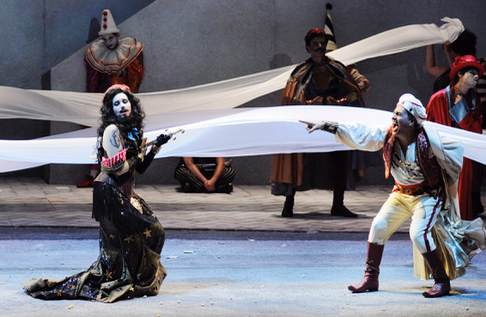 Erwin Schrott as Selim recognizing Cecilia Molinari as Zaida in Act I
Erwin Schrott as Selim recognizing Cecilia Molinari as Zaida in Act I
The greatest charm of the evening was the sheik Selim, sung by Uruguay born, Italian trained baritone Erwin Schroit [FYI former partner of Anna Netrebko] who had no more to do than walk onto the stage to steal the show. He reinforced the physical mannerisms of Fellini's White Sheik with powerful voice, simply making the world turn about him. This made it all the more fun for Prosdocimo to try to lay out his comedy, which veteran Italian baritone Pietro Spagnoli did with equal panache and volume, if not with such overwhelming charm.
The third anchor of the comedy was Narcisco sung by young American tenor René Barbera whose priestly presence was complicated by his masochistic relationship with Saraghina and his travestimento as the sheik for the masked ball. True blue chip casting held sway with Nicola Alaimo, Pesaro and Monaco’s William Tell as the cuckolded husband, Geronio, this artist’s famous girth bouncing lightly in a graceful tumble when kicked over by Fiorella.
Fiorella was impersonated to great effect by Russian soprano Olga Peretyatko, who like her portrayal of the same role at the 2014 Aix Festival succeeded as the character without assuming the stature of voice or technique to bring the role fully to life. Young Italian mezzo-soprano Cecilia Molinari, a participant in the Rossini Festival’s Accademia held her own as a bearded Zaida. Her side kick Albazar was sung by cross-dressed tenor Pietro Adaini who was wittily hauled off the stage during his aria by stagehands preparing the movie set for the finale.
Michael Milenski
Cast and production information:
Selim Erwin Schrott, Fiorilla Olga Peretyatko, Geronio Nicola Alaimo, Narciso René Barbera, Prosdocimo Pietro Spagnoli, Zaida Cecilia Molinari, Albazar Pietro Adaini
Coro del Teatro della Fortuna M. Agostini; Filarmonica Gioachino Rossini. Conductor: Speranza Scappucci; Stage Director and Set Design: Davide Livermore; Videodesign: D-WOK; Costumes: Gianluca Falaschi; Lighting: Nicolas Bovey. Teatro Rossini, Pesaro, Italy, august 12, 2016.
image=http://www.operatoday.com/Turco_Pesaro4.png
product=yes
product_title=The Turk in Italy at the Rossini Opera Festival
product_by=A review by Michael Milenski
product_id=Above: Paolo Spagnoli as Prosdocimo, Fellini showgirl, Olga Peretyatko as Fiorella (on right) [All photos courtesy of and copyrighted by the Rossini Opera Festival]
August 15, 2016
Proms Chamber Music 5: Shakespeare at 400
On this occasion, the vocal ensemble Stile Antico and the viol consort Fretwork joined forces to present music by Shakespeare’s contemporaries and settings of Shakespeare old and new. Once the two groups of performers had adapted to the venue, and to performing with each other, they communicated a striking sensitivity to Elizabethan sensibility, iconography and poetic conceits as embodied in musical forms and language. And, they captured the era’s notions of fluent artistry which deliberately, and sometimes ostentatiously, displays both its own grace and its complexity.
But, we began with light spirits: Thomas Morley’s ‘It was a lover and his lasse’ the text of which is drawn from As You Like It (V.iii). It’s interesting to reflect on whether Morley and Shakespeare knew each other: they both lived in Bishopgate in the late 1590s, and the contemporary artistic community embraced poets, actors, musicians and composers. Morley’s madrigal is a jovial, springy - and slyly bawdy (‘with a hey, and a ho, and a hey nonny no’ foregrounds a contemporary euphemism!) - madrigal which describes a loving couple’s ‘roll in the hay’. Originally for three voices, it was arranged here by Andrew Griffiths for three groups of four unaccompanied voices for each of the first three stanzas, with the twelve voices joining together for the final verse. And, although there was an attempt to conjure the relaxed intimacy of domestic music-making of the period, Stile Antico offered a fairly innocent reading! It took them a little time to settle though, and the various vocal groups struggled to find a balance that appropriately foregrounded the upper voice, which carries the melody, the dark colours of the lower voices tending to out-weigh the buoyancy of the sopranos, though the text was clearly conveyed.
There were some intonation hiccoughs in Byrd’s ‘O Lord, make thy servant, Elizabeth’, as the voices struggled to accord their timbre with that of the five viols of Fretwork, but by the concluding, elaborate ‘Amen’ these problems had been ironed out and in the subsequent, ‘Why doe I use my paper, inck and pen?’ tenor Benedict Hymas worked fluently with the viol counterpoint - underpinned by Richard Boothby’s expressive and mobile bass line. The text was written by Henry Walpole on the occasion of the execution of Edmund Campion, and Byrd - who had established himself as one of Queen Elizabeth’s favourites - was nevertheless taking a few risks: the only previous attempt to publish the poem had resulted in the torture and execution of the publisher! We would not have sensed this danger, though, from Hymas’ tone, which had the effete lightness of Nicholas Hilliard’s Young Man Among the Roses; but occasionally as the phrase rose high, though the sound was sweet, the line was not sustained. The tierce de Picardie close was beautifully poignant, though: ‘An Angel’s trump were fitter to sound/Their glorious death, if such on earth were found.’
Thomas Tomkins’ ‘Be strong and of good courage’, sung by seven singers, was marred by some untidy interaction between voices and viols, and by the occasion tendency of the sopranos to push sharp-wards - which was noticeable at the final cadence. Robert Ramsey’s ‘Sleep, fleshly birth’, however, was stunning. Ramsey, director of music at Trinity College Cambridge, is probably a name less familiar to us than that of Morley, Byrd, Tomkins et al: his dramatic madrigal in six movement, Dialogues of Sorrow upon the Death of the Late Prince Henry, is only partially extant, but ‘Sleep, fleshly birth’ is almost certainly a tribute to the Prince. Stile Antico milked the chromatic piquancy for all it was worth, without the slightest hint of mannerism, and this performance has sent me scurrying to find recordings of Ramsey.
The twelve singers of Stile Antico showed intelligent awareness of the formal procedures of the music of the period in Robert Johnson’s ‘Full Fathom Five’, a setting of The Tempest (I.ii) in which ascending modulations in the first part are countered by a descent in the second, suggestive of the rise and fall of currents from the ocean floor, and the resurrection and laying to rest of the father’s spirit to the repetitions of ‘ding-dong bell’.
The programme also included two modern settings of Shakespeare. The first, Huw Watkins’ ‘The Phoenix and the Turtle’ (2014), is wonderfully responsive to the rhythmic energies and formal implications of the language. The twelve voices signalled loudly the opening command, ‘Let the bird of the loudest lay,/On the sole of the Arabian tree,/Herald sad and trumpet be’, establishing an animated momentum which burst through the sprung rhythms of motifs such as the ‘death-defining swan’. They later gave way, though, to quieter reflection allied with twisting dissonances which recalled the false relations of the Elizabethan madrigal. In slower, homophonic episodes the bass’s long pedals served as a reliable anchor for chromatic inflections, particularly in the final prayer-like section where the triple-time reflects the three-line stanzas. This text, which describes a funeral for the Phoenix and Turtledove, emblems of flawlessness and devotion respectively, has been described as one of Shakespeare’s most obscure poems, and one of the first metaphysical poems.Stile Antico, and Watkins, made it perfectly accessible. The close was magical: after a deliberating treat and pause, ‘For these dead birds’, the upper voices were released to ‘sigh a prayer’.
The lower voices in Nico Muhly’s ‘Gentle Sleep’ (2015) ululated like a primordial lullaby while tenor and soprano alternated in offering pronounced statements against this paradoxically soporific yet energised texture. The isolation of the silvery soprano, set against lively movement of the alto and tenor viols within the counterpoint, and the static low voices, was scintillating.
Fretwork offered some Fantasias and In nomines between the vocal works. Byrd’s Fantasia a 5 - ‘Two parts in one in the fourth above’ - was typical of the way the ensemble balanced timbral blend with the animation of individual instrumental lines, with once again Boothby’s bass line giving direction to the more dance-like episodes. The pacing of Byrd’s Browning a 5, ‘The leaves by green’ was well-conceived, particularly given its strangely truncated ending. Orlando Gibbon’s In nomine a 5 No.1 in D minor perhaps most wonderfully captured the era’s blend of melancholy, measure and mellifluousness.
John Wilbye’s ‘Draw on, sweet night’ brought the programme to a close, the delicious, and brave, diminuendo in at the close - ‘And while thou all in silence dost enfold’ - giving way to new animation in the final insistence: ‘I then shall have best time for my complaining.’ This was a perfectly constructed programme, delivered with a real sense of engagement with the ethos of the works performed and the texts set. We didn’t really need an encore of Gibbons’ ‘The Silver Swan’, but who would complain?
Claire Seymour
Proms At … Cadogan Hall
Stile Antico and Fretwork
Thomas Morley, ‘ It was a lover and his lass’; William Byrd, ‘O Lord, make thy servant Elizabeth’, ‘Why do I use my paper, ink and pen?’; Huw Watkins, ‘The Phoenix and the Turtl’e’, William Byrd; Fantasia a 5 - ‘Two parts in one in the fourth above’; Thomas Tomkins, ‘Be strong and of a good courage’; Robert Ramsey, ‘Sleep, fleshly birth’; William Byrd, Browning a 5, The leaves be green’; Robert Johnson, Full fathom five’; Nico Muhly, ‘Gentle sleep’; Orlando Gibbons, ‘In nomine a 5 No.1 in D minor; John Wilbye, ‘Draw on, sweet night’.
Cadogan Hall, London; Monday 15th August 2016.
image=http://www.operatoday.com/stile%20antico.png image_description=Proms Chamber Music 5 at Cadogan Hall product=yes product_title=Proms Chamber Music 5 at Cadogan Hall product_by=A review by Claire Seymour product_id=Above: Stile AnticoLa donna del lago in Pesaro
La donna del lago is from Naples’ Teatro San Carlo in 1819. Rossini masterpieces abound in these years, though they were not always appreciated by the fickle Neapolitan audience who in 1818 had wildly applauded Spontini’s La Vestale and decried Rossini’s Ermione. Consequently in 1819 Spontini had a contract for two new operas at San Carlo and Rossini had none! Circumstances forced Spontini to back out, but Rossini, always ready, took over the contract.
The novels of Sir Walter Scott were in the air in French translation. It is fairly likely that La donna del lago was originally intended for Spontini. But Rossini gets the credit of creating the first Italian opera based on Scott’s wildly popular, colorful novels that gave first definition to European theatrical Romanticism!
The now infamous Venetian stage director Damiano Michieletto staged La donna del lago just now in Pesaro. Last year at Covent Garden Michieletto had Jemmy, William Tell’s son compare his father Guillaume Tell with a comic book William Tell brought alive, played by an actor who remained on stage for the duration of that opera. In recent years in Pesaro Michieletto has turned La scala di seta into pure run-of-the-mill TV sit-com and Sigismondo into a classic made-for-TV horror movie (low budget, low taste).
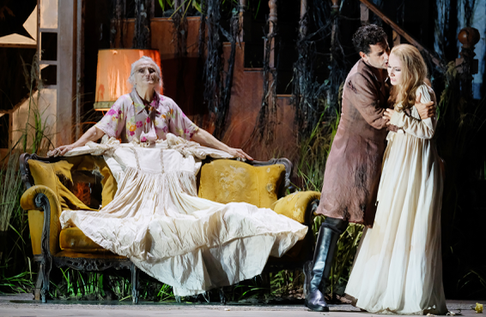 Elena double, Juan Diego Flórez as Uberto, Salome Jicia as Elena
Elena double, Juan Diego Flórez as Uberto, Salome Jicia as Elena
It was a surprise to see Michieletto back on the Pesaro directorial roster but it was of no surprise to learn that La donna del lago had become two old folks in a probably-mid-twentieth century British Isles-someplace parlor having a spat about the wife’s infatuation with a black and white photo of the king. The couple became a duplicate, aged Elena (the lady of the lake) and Malcom, a duplicate of the opera's pants role rebel but who (the double) was a real male. The doubles shadowed their Scottian counterparts the entire evening. Not to give it all away but towards the end the old woman falls into the lake (real water for this dramatic backflop) and Elena finds herself back in the drawing room of the opening scene. She transforms herself into the old woman while singing her final spectacular and breathtakingly beautiful “Tanti affetti in tal momento” that ends the show in the old folk’s reconciliation.
Elena was sung by Pesaro-finished (the festival's Accademia Rossiniana) ingenue Rossini diva, Georgian soprano Salome Jicia who more than held her own amid stiff competition — Jean Diego Flórez as King James V who liked to wander the Scottish countryside incognito and — according to Sir Walter Scott — fall in love with beautiful young women, and American tenorino cum coglioni Michael Spyres as Rodrigo, Malcom’s brash competition (lots of leaps to forte C’s and D’s).
Malcom was sung by Armenian mezzo soprano/contralto Varduhi Abrahamyan, an accomplished Carmen as well as bel canto singer who is well able to cross dress when called upon (last spring’s Ascanio in Benvenuto Cellini in Rome as example). Her first act aria “Elena! oh tu, che chiamo” earned the huge Pesaro ovation — uniique to Pesaro these ovations extend multiple minutes and are homage to a singer, to Rossini and to simply being a Rossini afecionado in Pesaro. This fine artist is of ample voice and excellent technique, a very welcome newcomer to the limited ranks of Rossini pants role interpreters.
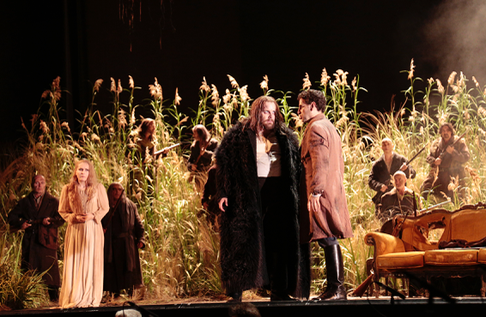 Salome Jicia as Elena, Michael Spyres as Rodrigo, Juan Diego Flórez as James V / Uberto
Salome Jicia as Elena, Michael Spyres as Rodrigo, Juan Diego Flórez as James V / Uberto
Among the great moments of the evening was the second act scena in which the incognito James V reveals himself to Rodrigo and then kills him in a duel but not before the two tenorinos deliver the splendid duet “Vendetta! accendi mi di rabbia il seno” before which the lady of the lake suggests they kill her instead of themselves even though she loves neither one of them. In these moments it is clear that Juan Diego Flores has no equal in finding the joy of singing (this the genius of Rossini) and Michael Spyres is among the few who truly deliver the excitement of a Rossini voice.
The biggest of all the ovations was however reserved for Pesaro conductor Michele Mariotti, now an international star, who has naturally absorbed the Rossinian esprit, and like no other is able to communicate it to his orchestra in the pit, here the Orchestra of Bologna’s Teatro Comunale and to the singers on the stage with whom you feel and can actually see the joining of voice to the sentient Rossini orchestra. On this occasion Mo. Mariotti’s tempos seemed more deliberate than sweeping, possibly in sympathy to Mr. Michieletto’s very precise storytelling, and possibly in response to Rossini’s newly found Romantic colors — the specific horn calls and the momentary crowning of intense moments with sharp flute tones, and the always important clarinet in introduction and duet with the stage. Strangely this evening did not come across as the great Rossini.
Set design by Paolo Fantin was indeed splendid, superimposing the drawing room on the swampy lake shore, spectacularly lighted by Alessandro Carletti. Said and done the self-consciously chic Michieletto staging did indeed enhance the evening, the doubling of Elena and Malcolm adding a dramatic depth and possibly too comprehensible human emotion to this exotic tale of long ago and far away. Would that it not have been so prosaic.
Michael Milenski
Cast and production information:
James V / Uberto: Juan Diego Flórez; Duglas: Marko Mimica; Rodrigo: Michael Spyres; Elena: Salome Jicia; Malcom: Varduhi Abrahamyan; Albina: Ruth Iniesta; Serano / Bertram: Francisco Brito. Elena (silent); Giusi Merli, Malcom )silent) Alessandro Baldinotti. Orchestra e Coro del Teatro Comunale di Bologna. Conductor: Michele Mariotti; Metteur en scène: Damiano Michieletto; Set design: Paolo Fantin; Costumes: Klaus Bruns; Lighting: Alessandro Carletti. Arena Adriatica, Pesaro, Italy, August 11, 2016.
image=http://www.operatoday.com/LakeLady_Pesaro1.png
product=yes
product_title=The Lady of the Lake at the Rossini Opera Festival
product_by=A review by Michael Milenski
product_id=Above: Salome Jicia as the lady of the lake, Marko Mimica as Duglas [All photos courtesy of and copyright by the Rossini Opera Festival, Pesaro]
Proms at … Sam Wanamaker Playhouse
The Timon of Athens excerpts opened with a Curtain Tune of decidedly ‘world’-‘jazz’ inflection. I have nothing against such an approach at all, but it seemed a bit of an easy option here, as if offering a touch of - highly predictable - ‘swing’ and some ‘colourful’ percussion was all that was required. We seemed on surer ground with ‘I spy Celia’. Our tenor and bass, Samuel Boden and Callum Thorpe, dressed in matching white T-shirts and jeans offered strutting performances: ‘I am redder, then I please her’. Boden’s ‘I see she flies me’ showed off again his splendid, light but not too light tenor, the coloratura negotiated with nonchalant ease. There was languorous contrast in Dryden’s lines, ‘Were she but kind whom I adore/I might live longer, but not love her more.’
What we still believe to be the first English opera, Venus and Adonis followed, again, as in all cases this afternoon, in excerpted form. Two recorders and harpsichord gave us the Act I ‘Tune for flutes’, in nicely unhurried fashion, again a welcome contrast with what had gone before. Further music from the first act - a sequence opening ‘Venus! … Adonis!’ and the music surrounded by the Hunters’ Music - followed. Thorpe’s chocolatey bass seemed ideally suited to the role of Adonis, whilst his Venus, Katherine Watson, proved equally stylish, ‘English’, but in a good way. The Hunters’ Music again revived the ‘popular’ element, this time with tambourine; much to its benefit, it was varied, more intense, the second time around. (Yes, I know I am being a bit of a puritan; please forgive me.)
Music from The Fairy Queen followed, excerpts selected from Acts I, III, and V. The opening Prelude (First Music) was fast and furious - for better or for worse. The following Hornpipe was well judged, with a winning swing, colourful too. The Act V Prelude showed an air of unease, followed by the Second Music-Rondeau, which proved graceful of lilt. ‘If Love’s a Sweet Passion’ benefited from a lovely oboe solo, sounding almost like a soft-spoken trumpet at times, at others thoroughly pastoral. Dances from that same, third act followed: for the Fairies, a Hornpipe, and for the Haymakers, the ‘Dialogue between Coridon and Mopsa’ just before that final dance. Done up in lipstick, newly clad in a pashmina, Boden played the countertenor-ish maiden, blessed with beautiful deportment too. Alessandro Talevi had certainly prepared the participants well for a highly erotic conclusion. The Chaconne: Dance for a Chinese man and woman rounded off the first half.
Opening the second were two pieces from Matthew Locke’s incidental music to The Tempest, a 1674 production much loved by Nell Gwynne. The music - Curtain Tune and Dance of the Fantastick Spirits - was interesting to hear, but paled somewhat next to that of Purcell (even ‘Purcell, attrib.’). Purcell’s 1695 music, if indeed it is by Purcell, followed. Thorpe’s rendition of ‘Arise, ye subterranean winds’ was commanding, duly declamatory. Watson’s ‘Full fathom five’, later joined by her tenor and bass colleagues, proved a charming item to follow. Her ‘Dry those eyes’ offered a vocal line both clear and melancholic, with fine playing too from the members of Arcangelo. Finally, ‘Neptune’s Masque’ provided opportunities, well taken, for all to shine. Neptune’s lengthy air again received a commanding yet subtle performance from Thorpe. Aeolus, summoned by the god, appeared in black leather jacket and shades all over the theatre. His ‘Your awful voice’ was as agile both vocally and in stagecraft. There was some able fiddling too. The closing chorus had more than a hint of ‘authentic’ Purcellian melancholy, whoever the actual composer may have been.
Mark Berry
Excerpts from: Purcell, The History of Timon of Athens, The Man-Hater; Blow, Venus and Adonis; Purcell, The Fairy Queen; Locke, The Tempest; Purcell (attrib.), The Tempest. Katherine Watson (soprano); Samuel Boden (tenor); Callum Thorpe (bass); Alessandro Talevi (movement director)/Arcangelo/Jonathan Cohen (director, harpsichord, organ). Sam Wanamaker Playhouse, Globe Theatre, London, Saturday 13 August.
image= http://www.operatoday.com/Wanamaker%20Prom.png image_description=Proms Matinee at Sam Wanamaker Playhouse product=yes product_title=Proms Matinee at Sam Wanamaker Playhouse product_by=A review by Mark Berry product_id=Above: Arcangelo directed by Jonathan Cohen at the Sam Wanamaker PlayhousePhoto credit: Chris Christodoulou
August 12, 2016
Santa Fe: Straussian Sweet Nothings
I am not sure there is any opera that has less action or has less at stake than this infrequently staged opus. Two suitors argue (and that is really too strong a word) their case to a Countess, positing which is more important in opera, the music or the words. And there is the plot. Yes, all of it. The Countess must choose, and in so doing, favor one man over the other.In a wonderfully varied Santa Fe Opera 60th Anniversary season that had young lovers committing suicide, bandits almost being hanged, a jilted young woman resigning to numbing isolation, and an immoral wastrel being dragged to hell, by contrast this Strauss is hardly riveting stuff. Luckily, Santa Fe selected an incomparable cast and lavished Capriccio with a dazzling production, lovingly led by a commanding new (to me) conductor.
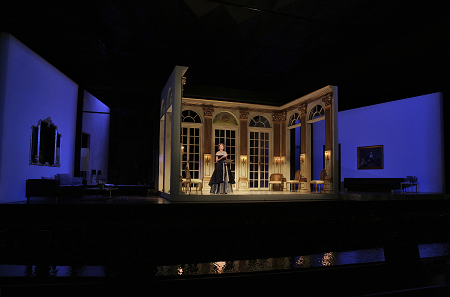 Amanda Majeski (The Countess). Photo Credit: Ken Howard.
Amanda Majeski (The Countess). Photo Credit: Ken Howard.
Amanda Majeski seems pre-destined to play the Countess. Her cool, secure, limpid soprano is just what Strauss had in mind when he endowed the role with lovely conversational passages, airy flights above the staff, and haunting musings on the philosophies of art and music. Ms. Majeski’s pure tone and knowing, fluid delivery harkens back to great Strauss interpreters of the last century, a direct connection to (or at least recollection of) a revered roster of interpreters.
Her traversal of the Countess’s last great monologue was a thing of great beauty, infinite variety, and sublime vocalization. Moreover, Amanda has a regal and poised presence, her carriage leaving no doubt that she is “royalty.” Her achievement is such that she may just be unequalled in this part at the moment (pace, Renée-sayers).
The charming, natty Ben Bliss was a most convincing Flamand. Lanky and handsome, sweet of voice and behavior, his assured tenor was just the right fit for the demands of the role. His warm, effortless singing and his charismatic presence proved a wholly winning combination. As Olivier, dapper Joshua Hopkins was a scrappy bulldog of a rival, barking counter arguments in a petulant, resonant baritone. Mr. Hopkins has shown before that he is not only a consistently secure vocalist, but also an imaginative actor.
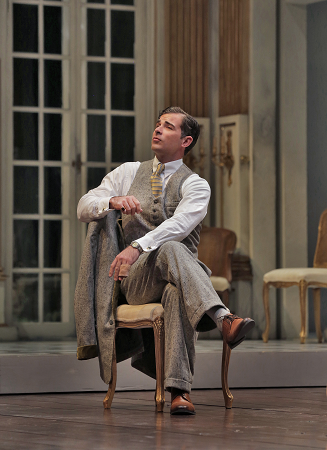 Craig Verm (The Count). Photo Credit: Ken Howard.
Craig Verm (The Count). Photo Credit: Ken Howard.
Rising baritone Craig Verm keeps going from strength to strength. Having turned in a fine performance as Sonora in Fanciulla, Mr, Verm impressed even more as the rather changeable, effete Count. His easily produced, suave delivery served the role with distinction. David Govertsen found sardonic delight in the role of La Roche, and his direct approach and easy cynicism were served by well-controlled vocalism.
It was deluxe casting to have superstar Susan Graham in the lesser role of Clairon, and she embraced the assignment with relish. Ms. Graham sang with her usual aplomb, and her world-class mezzo discovered every rich gradation of this starry featured role. Adrian Smith brought a resigned gravity in the Major-Domo, Allan Glassman was a rambunctious Monsieur Taupe, and Galeano Salas and Shelly Jackson made notable contributions as the Italian Singers.
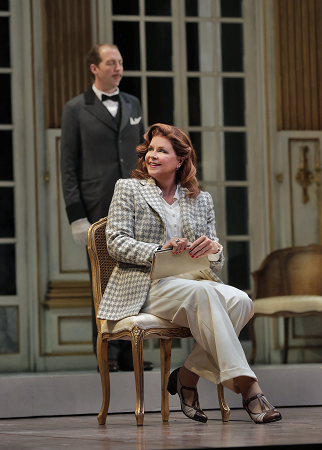 Susan Graham (Clairon). Photo Credit: Ken Howard.
Susan Graham (Clairon). Photo Credit: Ken Howard.
Tobias Hoheisel has designed both scenery and costumes for Capriccio, and I cannot imagine a more resplendent realization. Such is his achievement that the real existential question of the night might be: Which are more beautiful? The costumes? Or the sets? The Countess’s beautiful mid-20th Century home is all elegant windows open to the Sangre de Cristo mountains, with the furniture and other appointments an apt study in refinement and affluence. The side compartments antechambers and playing spaces off the living room are evocative of many a European villa I have seen.
Mr. Hoheisel’s period (1940’s?) costumes are breathtaking in their luxurious specificity. Any actor that gets such consummate costume assistance in communicating a character is fortunate, indeed. Malcolm Rippeth’s lighting design has bathed all this noblesse in a beautifully tinged wash of warmth that slowly morphs from daytime into a moodier look as the arguments sharpen and introspections deepen.
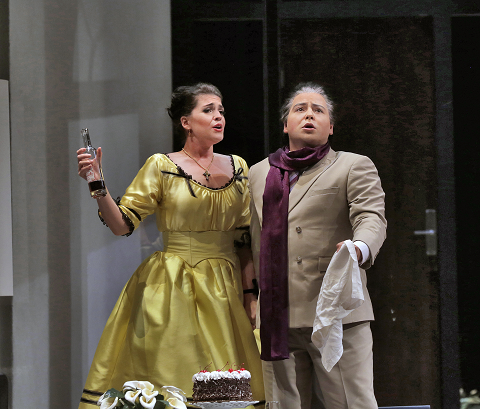 Shelley Jackson and Galeano Salas (Italian Singers). Photo Credit: Ken Howard.
Shelley Jackson and Galeano Salas (Italian Singers). Photo Credit: Ken Howard.
Tim Albery has directed with unfussy precision, allowing the confrontations to unfold gently and tellingly. His genius has been in allowing his consummately gifted cast to naturally make a case for this gentle opus. Mr. Albery never ‘got nervous’ and tried to gild the lily by inventing extraneous distractions. Everything he did was honestly in service to the score and the text. That said, I thought the extended on-stage prelude might have benefitted from a little more movement, sooner furthering a subtext of relationships. But all in all, this was a beautifully restrained, stylistically informed interpretation.
Conductor Leo Hussain was a revelation in the pit, helming a delicate, fluid, mesmerizing, echt account of a graceful score that is more succulent caviar than substantial Hauptspeise. From the churning string ensemble of the prelude to the confrontational dialogue at the score’s core, to the rhapsodic meditation of the closing quarter of the opera, Maestro Hussain led a propulsive, informed, precise reading that fell gratefully on the ear.
Santa Fe has a long and happy relationship with the operas of Richard Strauss. On this occasion of the 60th anniversary season, it is a pleasure to report that partnership is not only alive and well, but is still resulting in definitive interpretations.
James Sohre
Strauss: CapriccioFlamand: Ben Bliss; Olivier: Joshua Hopkins; La Roche: David Govertsen; Countess: Amanda Majeski; Count: Craig Verm; Clairon: Susan Graham; Major-Domo: Adrian Smith; Italian Singers: Galeano Salas, Shelly Jackson; Monsieur Taupe: Allan Glassman; Young Dancer: Beth Miller; Conductor: Leo Hussain; Director: Tim Albery; Set and Costume Design: Tobias Hoheisel; Lighting Design: Malcolm Rippeth; Choreography: Jodi Melnic.
5th August 2016.
image=http://www.operatoday.com/3.%20Joshua%20Hopkins%20%28Olivier%29%2C%20Amanda%20Majeski%20%28The%20Countess%29%2C%20David%20Govertsen%20%28La%20Roche%29%2C%20and%20Ben%20Bliss%20%28Flamand%29%20in%20%27Capriccio%27.png
image_description=CapriccioCapriccioCapriccio
Photo credit: Ken Howard for Santa Fe Opera, 2016
August 11, 2016
Santa Fe’s Civil War Gounod
This handsome set design was crafted by Ashley Martin-Davis, and once we accepted this repurposing of the well-known story, it became quite striking how many parallels could be drawn. Our civil strife after all pitted “family against family,” and the metaphor had considerable resonance. The “battles” between the opposing forces played out with dramatic truth, and the irrational, unavoidable love between two youngsters from opposing sides was heightened by framing it in this fresh context.Director Stephen Lawless mined great dramatic potential in collaboration with this prodigiously gifted scenic artist, who also contributed a remarkably fine costume design. The austere unit structure included a high staircase stage right that easily suggests Juliette’s balcony. In the first choral scene, a trap reveals a plinth, rising to stage level with the lovers’ coffins. This effect returns in the final tomb scene, lifting ‘dead’ Juliette from the floor where she had collapsed, to seamlessly create her funeral bier. Meaningfully, the lovers’ nuptial bed had also risen into view from the same trap.
Ms. Martin-Davis suggested other scenes with the simple addition of such things as the altar railings, a profusion of vases with white wedding flowers (that get repositioned around the dead Juliette), a statue of Cupid that informs the balcony scene, and a military field hospital. A goodly number of hidden doors are imbedded in the imposing walls, and the basic structure can adapt to have whole segments swing into new positions, redefining the space. Completing the stellar design team, Mimi Jordan Sherin contributed a diverse and brooding lighting design, characterized by unusually effective use of stark, shadowy cross-lighting.
Back to the ravishing costumes, Ms. Martin-Davis created some unforgettable moments. The chorus women initially appeared in handsome black mourning gowns for the opening dirge, then the women stripped off those outer garments in a trice to reveal alluring white versions of those same costumes as Gounod transitions to the party scene. The richly detailed uniforms of the soldiers were not the Blue and the Grey, but rather the Blue and the Red, which made for a more vibrant visual.
Director Lawless has created memorable stage pictures and effective interaction between the protagonists that furthers the story and engages the spectators. The overall scope of the well-motivated movement is first rate. A major plus is the lively, well-coordinated fight choreography by Rick Sordelet and Christian Kelly-Sordelet. A caveat: When two characters have been ‘killed’ after a strenuous, active duel, please do not have Tybalt and Mercutio ‘die’ on their backs, revealing their uncontrollably heaving bellies as they gasp to regain their breath!
Nicola Bowie contributed appropriate choreography with some simple and effective court dances. I have never seen the actual ballet included, and the two ballerinas Beth Miller and Susan Vishmid were poised and skilled. However, if the extraneous dances are to be added, I wish they might have engendered more dramatic character and elan, lest they merely serve to lengthen a long evening.
Ailyn Pérez proved a delectable Juliette. Making her entrance down the upstage stairs like a gangly schoolgirl walking in heels for the first time (as she faltered Gertrude gave her a hand), she was believably youthful, and radiantly pretty. As love’s complications progressed, Ms. Pérez suggested a moving and honest maturation. Her soprano is one of the glories of the current crop of operatic talent, and once past a slightly bumpy Je veux vivre, her rich, responsive singing found all its usual sheen and nuance. The poison aria was characterized by an inexorable build to a searing climax, and proved the evening’s musical highpoint.
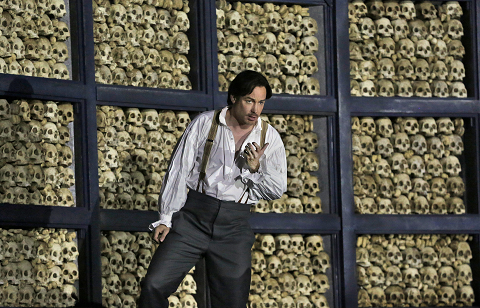 Stephen Costello (Roméo). Photo Credit: Ken Howard.
Stephen Costello (Roméo). Photo Credit: Ken Howard.
Stephen Costello was a fine match as a mooning, boyishly appealing Roméo, although he seemed somewhat distracted at the start, as if wishing to be somewhere else. He soon enough warmed to his task as the first encounter with Juliette developed more ease and urgency. Mr. Costello’s appealing tenor is well-focused, dramatically exciting, and thrillingly stentorian. Maybe sometimes “too.” While a handful of the very highest notes displayed more tenacity than gleam, it would be hard to wish for a more authoritative reading of Gound’s hero. And bravo to Stephen for brazening it out when, after an ear-splitting thunderclap and blinding flash of lightning from Mother Nature, he managed to convincingly say how the tomb was “so dark and silent!”
These two accomplished titular singers are conscientiously going through all the right motions, striking all the right poses, stroking, smooching, snuggling, and more. They are visually perfect and vocally splendid. But at the end of the day, at the risk of seeming ungrateful, I wonder if even more real dramatic heat and musical sparks might have been generated?
Deborah Nansteel has such a plummy, ingratiating mezzo that she made an exceptionally striking presence as Gertrude, the finest of my experience. Ramond Aceto’s solid Frére Laurent not only heals heartsick souls, but does double duty patching wounded bodies as head surgeon in a military hospital. Mr. Aceto has a firmly grounded bass-baritone that moved us with its bold, luminous tone and concentrated dramatic purpose. Mezzo Emily Fons was a thoroughly adorable Stéphano, and her agile, distinctive way with Que fais-tu, blanche tourterelle was enchanting.
Elliot Madore has lost some of the incisive, youthful gleam in his attractive baritone, but the tradeoff is that he now effects a more swaggering, if more diffuse vocal presence. His energetic acting, strapping physique, and aggressive singing serve Mercutio well, although his impersonation is marred by a ‘bit’ of mugging. His Queen Mab aria was a personal best, with good variety and control.
Cooper Nolan strikes all the right poses and hits all the right notes as a scrappy Tybalt, and his fresh, flexible tenor shows good promise, even though is sometimes a mite covered. Tim Mix displayed a fine legato and beguiling tone as a capable Daddy Capulet, even while his instrument and demeanor are at the moment too youthful for the paterfamilias. It is impossible not to love Soloman Howard, blessed as he is with an ingratiating stage presence and a gorgeous, mellifluous bass-baritone. Mr. Howard commanded attention and admiration as the imposing Duke.
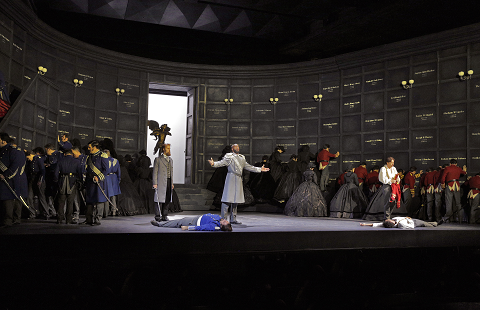 Tim Mix (Capulet), Soloman Howard (The Duke) and Stephen Costello (Roméo). Photo Credit: Ken Howard.
Tim Mix (Capulet), Soloman Howard (The Duke) and Stephen Costello (Roméo). Photo Credit: Ken Howard.
Music Director Harry Bickett infused the performance with just the right Gallic style, and he elicited emotion-infused playing from an orchestra that celebrated a full palette of color and effects. Ensembles, especially those involving Susanne Sheston’s fine chorus, were beautifully rendered. And Maestro Bickett’s partnership with the soloists was seamless and accommodating. If I had one musical wish, perhaps internal cues might be picked up. After more than one set piece, the pause was just long enough to prompt nervous, unneeded applause just as the next downbeat started. This gave an unnecessary stop and start feel to an otherwise commendable and forward thinking theatrical experience.
James Sohre
Gounod: Roméo et Juliette
Tybalt: Cooper Nolan; Paris: Thaddeus Ennen; Capulet: Tim Mix; Juliette: Ailyn Pérez; Mercutio: Elliot Madore; Roméo: Stephen Costello; Gertrude: Deborah Nansteel; Grégorio: Nicholas Davis; Frére Laurent: Raymond Aceto; Stéphano: Emily Fons; Benvolio: Peter Scott Drackley; Duke: Soloman Howard; Frére Jean: Adrian Smith; Lady Montague: Jasmine Quinsier; Dancers: Beth Miller, Susan Vishmid; Conductor: Harry Bickett; Director: Stephen Lawless; Set and Costume Design: Ashley Martin-Davis; Lighting Design: Mimi Jordan Sherin; Choreography: Nicola Bowie; Fight Directors: Rick Sordelet, Christian Kelly-Sordelet; Chorus Master: Susanne Sheston.
4th August 2016.
image=http://www.operatoday.com/3%20Ailyn%20P%C3%A9rez%20%28Juliette%29%20and%20Stephen%20Costello%20%28Rom%C3%A9o%29%20in%20%27Rom%C3%A9o%20et%20Juliette%27%20%28c%29%20Ken%20Howard%20for%20Santa%20Fe%20Opera%2C%202016.png
image_description=Ailyn Pérez (Juliette) and Stephen Costello (Roméo) in 'Roméo et Juliette' (c) Ken Howard for Santa Fe Opera, 2016
product=yes
product_title= Gounod’s Roméo et Juliette in Sante Fe
product_by=A review by James Sohre
product_id=Above: Ailyn Pérez (Juliette) and Stephen Costello (Roméo) in Roméo et Juliette
Photo credit: Ken Howard for Santa Fe Opera, 2016
August 9, 2016
Coolly Elegant Vanessa in the Desert
It is a luxury to see such an exhilarating new staging of this worthy opera, which seems to be finding its way back into favor after some years of unjustified neglect. Mr. Barber writes wonderfully for the voice, and here he crafts a treasure trove of haunting melodies that fall easily on the ear.
Conductor Leonard Slatkin seemed to revel in every bit of nuance in this splendid Neo-Romantic score, from the entrancing harmonies to the soaring melodies to the crackling through-composed dialogue that erupted into pungent arias. The eloquent orchestra responded with a generous outpouring of musical excellence underpinned by dramatic intent. Maestro Slatkin partnered his exceptional cast with unerring unity of purpose, and constantly shifting emotions were accommodated with consummate artistry, nowhere more so than in that shattering final quintet.
That cherishable artist Erin Wall shows once again that she ‘has it all’ as evidenced by her comprehensive, richly detailed, impeccable performance as Vanessa. Ms. Wall regales us with a creamy, warm, vibrant tone that is evenly produced in all registers and volumes. She is totally believable in her early reserve, which gives way, nay “explodes” into a pungent, tormented, mesmerizing characterization. Elegant to look at, ravishing to hear, impossible to look away from, Ms. Wall is a true star presence.
As her inexplicably devoted niece Erika, young Virginie Verrez impresses with a marvelous, refined mezzo that has individuality and polish. Her sound is voluminous, appealing, and displays a fine, even presence, especially in the score’s most famous melody, Must the Winter Come So Soon. Moreover she is slender and lithe, and moves well on stage. As accomplished her refined vocalizing is, I must say I missed Erika’s soul. Anguished cries that should suggest aching spiritual pain, were instead technically secure and intellectually apt. Erika should steal our hearts and run off with the show. I feel certain the gifted Ms. Verrez could come to do this as she discovers the part’s beating heart.
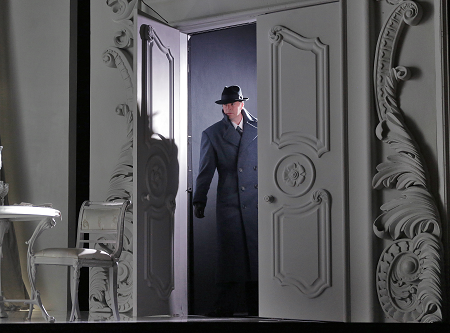 Zach Borichevsky (Anatol). Photo Credit: Ken Howard.
Zach Borichevsky (Anatol). Photo Credit: Ken Howard.
Rising tenor Zach Borichevsky has abundant appeal as the feckless Anatol. There is a devious sweetness about him that perfectly informs the opportunistic young man. That he also finds a crumb of honest feeling to throw to Erika makes him, if not honorable, at least two-dimensional. His singing has many moments of real beauty, and he is very persuasive encompassing honeyed sustained phrases. The exposed expansive upper stretches are more challenging and sometimes lie ‘just’ shy of the pitch, although Mr. Borichevsky serves them well enough with a subtly manufactured squillo that does the job without doing any harm. This role was written for Gedda after all, asking for a combination of suave insinuation and spinto power. Mr. Borichevsky is already making a good case for the part. Now it will be a pleasure to watch him grow.
It was a treat to see the much admired Helene Schneiderman whose inscrutable mezzo and seasoned dramatic presence made the most of every moment as the irascible Old Baroness. In her self-imposed silence, she even managed to suggest a begrudging (bemused?) attachment to Vanessa and Erika.
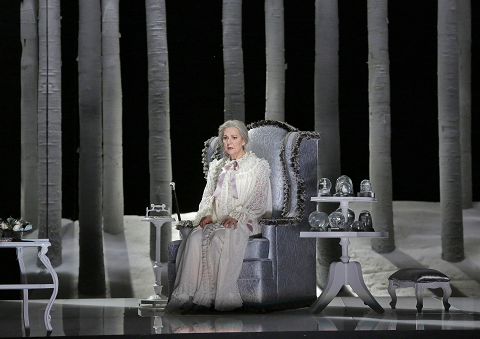 Helene Schneiderman (Old Baroness) in Vanessa. Photo Credit: Ken Howard.
Helene Schneiderman (Old Baroness) in Vanessa. Photo Credit: Ken Howard.
It was worth the price of admission just to see venerable bass-baritone James Morris in a star turn as the dotty Doctor. Mr. Morris is not only a valued asset in this production but also to the recent history of opera performance in general. What a generous, imaginative, gifted, engaging performer he is. It would be foolish to pretend that he is the fresh-voiced basso cantante of yore, or the potent Wagnerian of ‘mid-yore,’ and he doesn’t try to. Happily, he still has the all the charisma and assured technique to craft an unforgettable impression that is the talk of the festival. One of the week’s best moments was his: after he tenaciously clung and clung and clung to a loud extended high note, the delighted audience burst into spontaneous applause! Keep at it, Jim!
Allen Moyer’ handsome, white, film noir set designs (no that is not a contradiction) proved the perfect environment to underscore the aloof, wintery milieu. The imposing white drawing room features a curtained wall up center, which breaks away as it recedes upstage, curtain now drawn to reveal a huge cracked mirror, just as the false Anatol arrives. This powerful imagery at once underscored Vanessa’s fear of aging and the depleting properties of the passage of time, all the while reflecting (sorry!) her shattered dreams and illusions.
The openness of the dining table stage left (the congenial face of the family in public), is ingeniously offset by the cramped, skewed placement of two easy chairs far down right (the uneasy reality of the family in private). Indeed, at curtain rise Vanessa is in profile, her back somewhat to us, facing a stoic Old Baroness, both of them deliberately puffing on cigarettes.
The addition of a grand expressionistic staircase and chandelier up center dominated the visual as the space widened, just the characters’ life views opened up decisively. Erika’s march down those stairs to her attempted suicide was a potent effect. Erika’s bedroom was simply set down left when needed, with all of the subtle movement of set pieces neatly accomplished by costumed servants.
Spatial relationships were somewhat fluid, sometimes alienating, and most always effectively suggested. One puzzle: Once the large double doors were established as the main entrance with Anatol’s arrival, they were never so used again. Church- and partygoers exited up left, Erika ran out to escape her plight down right, Anatol entered carrying the lifeless girl from down left. Not good. Not bad. Just “curious.”
Finally, the presence of a tiered end table bearing snow globes from destinations that these reclusive inhabitants dream of visiting, was nothing short of a brilliant metaphor.
Costumer James Schuette has devised a doozy of a collection: elegant, posh, formalwear in a wide palette of neutral colors for many of the show’s official events: hosted dinners, engagement parties, church going, and leave taking. He has varied the look with attractive casual attire for day trips, skating parties and the like. Most important, Vanessa looked like the fashion plate she should be.
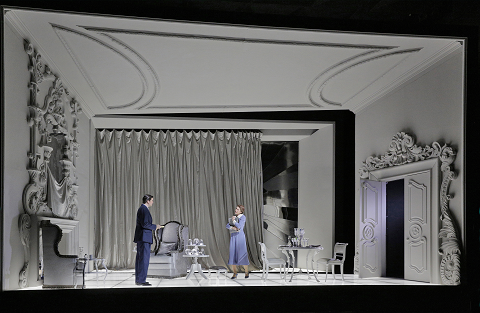 Zach Borichevsky (Anatol) and Virginie Verrez (Erika). Photo Credit: Ken Howard.
Zach Borichevsky (Anatol) and Virginie Verrez (Erika). Photo Credit: Ken Howard.
Christopher Akerlind contributed his usual top drawer lighting design. There was excellent use of stark white, shadowy cross lighting, and brooding washes. Since the set was white it took to subtle changes beautifully, and Mr. Schuette employed well-judged hints of color.
I happen to have been seated next to an Ibsen scholar, and what an apt parallel he drew to that style. Of course! The reserved formality of the period, the churning internalized dramatics of the drawing room, the talking past each other rather than to each other, it is all there, and director James Robinson craftily knit these elements into a most satisfying presentation.
Mr. Robinson drew detailed, multi-layered performances from his cast, and he showed an unerring eye for meaningful stage pictures. He kept many pieces of inventive stage business in play simultaneously while always skillfully keeping our focus on the main action. He and his team also crafted a unified plan to build the arc of the drama and then bring it full circle.
After Vanessa and Anatol leave for a brighter future, Erika packs up the snow globes and sends them after the couple. The set withdraws back to its original look. The mirrors are again covered. Erika sits in Vanessa’s easy chair facing a mute Baroness. They smoke as they face off. At the ending, we are back to a new beginning.
With Santa Fe’s illuminating production of Vanessa, we were privileged to participate in a cathartic journey, a perfectly realized evening of lyric theatre in which nothing, and everything, has changed.
James Sohre
Cast and production details:
Erika: Virginie Verrez; Major-Domo: Andrew Bogard; Vanessa: Erin Wall; Anatol: Zach Borichevsky; Baroness: Helene Schneiderman; Doctor: James Morris; Footman: Andrew Simpson; Conductor: Leonard Slatkin; Director: James Robinson; Set Design: Allen Moyer; Costume Design: James Schuette; Lighting Design: Christopher Akerlind; Choreography: Seán Curran; Chorus Master: Susanne Sheston
3rd August 2016.
image=http://www.operatoday.com/20.%20Erin%20Wall%20%28Vanessa%29%20and%20James%20Morris%20%28The%20Doctor%29%20in%20%27Vanessa%27%20%28c%29%20Ken%20Howard%20for%20Santa%20Fe%20Opera%2C%202016.png
image_description=Erin Wall (Vanessa) and James Morris (The Doctor) in Vanessa(c) Ken Howard for Santa Fe Opera, 2016
product=yes
product_title=Coolly Elegant Vanessa in the Desert
product_by=A review by James Sohre
product_id=Above: Erin Wall (Vanessa) and James Morris (The Doctor) in Vanessa
Photo credit: Ken Howard for Santa Fe Opera, 2016
Le Comte Ory, Seattle
Considering these hazards, Seattle Opera’s Le comte Ory should be considered successful. The piece contains some of Rossini’s freshest inventions, with the delirious final trio standing among his finest achievements. But the piece has suffered from from the beginning from its piecemeal and slapdash dramaturgy, and it has not aged well.
Only the farcical context of the story line rendered its “sexual politics” tolerable in 1828, and today its total reliance on the idea that seduction of the innocent is not just tolerable but uproariously funny means that even the most delicately contrived staging is going to exude the lingering odor of long-used locker rooms.
The staging, a first for Seattle by the Australian director-designer team of Lindy Hume and Dan Potra, does nothing to dispel the smell of stale sweat. The Seattle Opera publicity department’s attempt to fun-up the show by billing it as The Wicked Adventures of Count Ory signifies a broad-brush approach, confirmed in a program interview, where Ms. Hume’s hears in Rossini’s music not only “that he loved good food, good wine, a good time,” but even that “he was flawed, clever—and naughty.” Her dramaturgical touchstones include Monty Python’s Biblical send-up The Life of Brian and something described only as “60s flower-power.” (In the event the latter influence was noticeable only by an outburst of what may have been intended to suggest air-guitar and in the Count’s leopard-print boots.
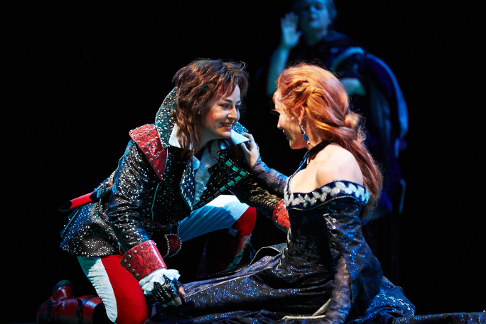 Hanna Hipp (Isolier) and Sarah Coburn (Countess Adèle).
Hanna Hipp (Isolier) and Sarah Coburn (Countess Adèle).
Mr Potra seems also to have been inspired by Monty Python—in this case by the bulgy colorful animations of Pythonite Terry Gilliam. But what amuses when it moves may lose its charm when it just sits there for an hour. The setting for the first act, which resembles a department-store show window upholstered in lumps and billows of emerald-green shag carpeting, is so vast and vacant that the cast and chorus resemble garden gnomes set about to enliven a miniature golf course.
Even powerful voices struggle for effect in this void. The second act setting goes to the opposite extreme, buttoning up the action in a three-story tin roofed lighthouse (or possibly a water-tower converted into a summer retreat). The compression somewhat helps with the acoustics but paralyses the performers, who are forced to spend much of their time hurrying up and down stairs. The great trio is crammed into an attic space that hardly allows the singers to move, let alone mime love-making.
Ms. Hume seems to believe in the stand-and-deliver approach for singers. I cannot remember any touch of insight into character or situation. In such a bald presentation, the musico-dramatic flaws of the piece stand out clearly. Why does the Tutor have that tiresome song in act one? Because the bass has to have an aria, of course. Likewise the drinking scene in Act II: without it the baritone would have nothing to do. With their total irrelevance to the action, the numbers let the energy leak out of the evening without providing any compensatory musical or comic payoff.
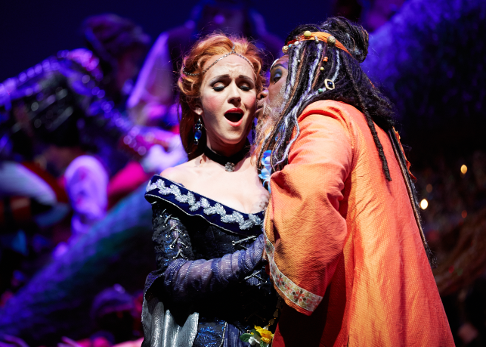 Sarah Coburn (Countess Adèle) and Lawrence Brownlee (Count Ory).
Sarah Coburn (Countess Adèle) and Lawrence Brownlee (Count Ory).
Abandoned to their own devices and muffled by the staging, the principals are to be commended for what they manage to put across. Worst off was Lawrence Brownlee as the count: dressed in an orange harem number in Act I (before being revealed as Michael Jackson-in-Boots), he seemed in poor voice: his high tenor was secure but rough-sounding throughout his range. The Isolier, Hanna Hipp, came off very well vocally but her acting was the generic operatic page-boy en travesti.
The only real winner was soprano Sarah Coburn, whom I suspect is on the verge of a major career in the Zerbinetta/Konstanze fach. Her warm, brilliant sound punched through the auditory scrim while her brisk behavior and sharp timing created a distinct impression of a woman devoid of airs and nonsense.
The orchestra gave firm support under the direction of Seattle debutant Giocomo Sagripanti, who appears to be a thorough master of Rossinian color and pacing. But musicianship alone can’t pull off a staging—and indeed an opera—with so many inherent obstacles to success.
Roger Downey
Cast and production details:
The Count: Lawrence Brownlee; Countess Adèle: Sarah Coburn; Isolier: Hanna Hipp; Raimbaud: Rodion Pogossov; The tutor: Patrick Carfizzi; Alice: Jennifer Bromagen; Madame Ragonde: Maria Zifchak; a noble: Eric Neuville. Stage director: Lindy Hume; Designer: Dan Potra; Lighting designer: Duane Schuler. Seattle Opera Chorus and members of the Seattle Symphony Orchestra, Giacomo Sagripanti (conductor).
image=http://www.operatoday.com/160802_Ory_pn_%20978.png image_description=Rodion Pogossov (Raimbaud), Lawrence Brownlee (Count Ory) and members of the Seattle Opera Chorus. [Photo by Philip Newton] product=yes product_title=Le Comte Ory, Seattle product_by=A review by Roger Downey product_id=Rodion Pogossov (Raimbaud), Lawrence Brownlee (Count Ory) and members of the Seattle Opera ChorusPhotos by Philip Newton
Racette’s Golden Girl in New Mexico
The part is after all, a Big Sing, and poses interpretive spinto requirements that challenge many a skillful soprano. To no one’s surprise, Ms. Racette mined gold out of the heroine’s wealth of diverse musico-dramatic material.
Indeed, It was hard to believe that this was her first outing with Fanciulla, such was her well-rounded understanding and highly effective communication of the role. Her instrument remains one of the most responsive and secure in operadom, and she possesses a distinctive womanly warmth from the lower to upper middle ranges that is impossible to resist.
She can be engagingly conversational one minute and highly excitable the next. When called upon, she can hurl out gleaming phrases above the staff that ring out thrillingly above the large orchestra. If she occasionally pushes the upper voice ‘just’ beyond its natural limit, it is always in heat-of-the-moment service to the drama. The love duet was meltingly voiced, and Patricia spun out filigrees of perfection in the Bible reading scene. In short, Patricia Racette is already among the top Minnie’s of our day, and from this starting point of ‘triumphant’ she is only going to get even better.
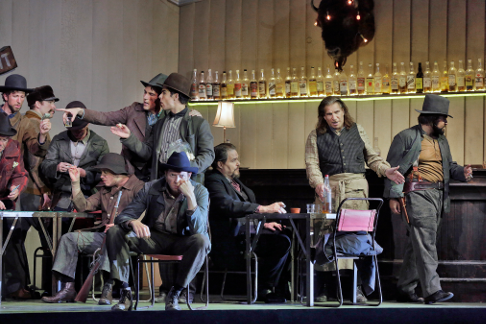 Ensemble cast
Ensemble cast
Mark Delavan seems born to play Jack Rance. His oversize presence and stage personality are wedded to an imposing, rock-solid, dark hued baritone. That awesome total package results in a perfect fit for the demands of the unyielding, unseemly, and unpleasant sheriff Jack Rance. This is my favorite role assumption to date for this accomplished, seasoned singer. Rance allows Mr. Delavan to show off all of his many strengths, and he proves an unrelenting vocal powerhouse. The intensity that he and Ms. Racette achieved in the famed Poker Scene was a model of its kind.
The full house seemed to enthusiastically enjoy brawny tenor Gwyn Hughes Jones even more than I did as Dick Johnson. There is much to admire in his evenly produced, heavy lyric tenor. He is especially wonderful when he is letting his clean, pleasing tone flow forth effortlessly with good legato. Mr. Hughes Jones has a bit less success when the going gets heavier, occasionally bearing down so that his lovely sound gets harder and less sympathetic. He was especially moving as he scored all the musical and emotional points in Ch’ella mi creda.
Allan Glassman offered a consistently interesting personality as the bar owner Nick, and his reliable tenor was deployed with insight and meaningful dramatic intent. Craig Verm’s rich, full-throated baritone made Sonora an important component in the evening’s success. It was luxury casting to have Raymond Aceto to lavish the part of Ashby with powerful phrasings from his pointed, polished bass-baritone.
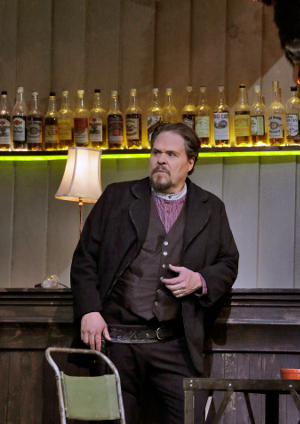 Mark Delavan (Jack Rance)
Mark Delavan (Jack Rance)
The entire gifted ensemble worked hard and well. Under Susanne Sheston’s assured leadership, choral singing was of a high standard. The many cameos were so well realized that it may be odious to single out any few. That said, Nicholas Davis’ rolling, mellifluous baritone made a significant impression as Jake; Adrian Smith’s well-voiced Larkens was memorably affecting; and Allen Higgs’ urgent, focused baritone made the most of his stage time as José Castro. Even the most thankless roles in the opera were well-served, with Kristen Choi bringing an appealing mezzo to Wowkle and James Harrington summoning bold, secure baritone singing as Billy Jackrabbit.
The most often heard comment the whole week I was at Santa Fe Opera: When you are doing an opera about the Golden West, and you have a stage with a back wall open to a genuine vista of ‘golden west’ hills, why cover up that natural match with a set? (And a not very atmospheric set at that.)
Well, the answer seems to be that this was a collaboration with English National Opera whose home theatre (the Coliseum) does not have nature’s scenery available (St. Martin’s Lane, anyone?) Still, set designer Miriam Buether has crafted a rather garish Polka Saloon that appears more a warehouse with spare appointments than an evocative Old West tavern. Indeed, once Mimi Jordan Sherin began her lighting design with sickly, day-glo green lighting, the place started out looking more like a wannabe hipster bar on the Vegas Strip. Once past that first impression, Ms. Sherin mellowed the look to an effective, unobtrusive collection of area washes and isolated specials.
Crowded placement of tables and chairs, with only one entrance upstage behind them, made for congested movement, and stymied a successful star entrance for Minnie. Still, the separate dance hall stage right and the secure room for the safe stage left were good touches even though they too lacked meaningful detail. Minnie’s cabin looked like a two-story Ikea dollhouse, all tidy and blond with clean angles. The wide upstage windows were covered by a drape that kept getting pulled open and closed, and the table and two chairs kept getting moved around with no tangible motivation. Curiously, the sound effect of wind gusts stayed at the same volume even when the door was opened or closed during a cue.
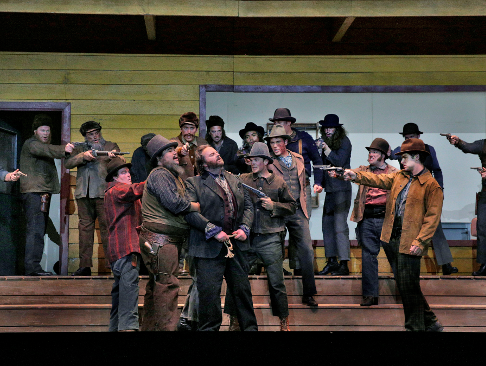 Gwyn Hughes Jones (Dick Johnson) and ensemble cast
Gwyn Hughes Jones (Dick Johnson) and ensemble cast
Act Three was not in the “Great Californian Forest at Dawn,” as specified in the script but rather on the wooden front porch/façade of the sheriff’s office building. This had a couple of steps what were used for rather formal choral groupings. The gun rack on the wall in Rance’s office, and the plethora of guns being trained on Johnson in this act began to seem like a commentary on the profusion of weapons in the US.
Nicky Gillibrand’s successful costumes were appropriately character-specific. Minnie’s Act Two ‘dress up’ look was not only fun but also meaningful. Ms. Gillibrand’s somewhat stereotypical ‘black’ attire for Rance was a witty, ironic comment on old west villains.
Richard Jones made interesting decisions in his staging and he was quite effective in scenes with smaller number of characters where he fostered good interaction, motivated blocking, and useful subtext. When Mr. Jones had to move larger numbers of people in Act One, he often left them clustered and cluttered, with an appearance of imprecise traffic control. Conversely, Act Three’s crowd scene was by turns too neat (with even lines of miners on the platforms), or too messily ‘violent’ to the point of being laughable. When Johnson gets methodically passed down the forward line of men from stage right to left, getting individually punched, kneed, and brutalized, I couldn’t help but think of that scene in Airplane, in which fellow passengers line up to take their turn at slapping a seatmate out of her hysteria.
Lucy Burge’s choreography for the miners’ dancing together in Act One was well coordinated and charming. However, having the group of men get on those Act Three steps like a show choir, raise a pistol in unison in their right hand and then, en masse, execute something that was a cross between The Pony and Arsenio Hall’s fist bumps was just plumb silly, totally out of character and context.
Best for last: the Santa Fe Opera orchestra was in absolutely superb form. From the first hammered chords, Emmanuel Villaume was firmly, thrillingly in charge of a reading that was stunning from initial downbeat to finale cut-off. The Maestro was a cunning Pied Piper, leading his amassed forces with meticulous dramatic intent and unfaltering attention to detail, whether nurturing articulate solo statements, or guiding lush ensembles (oh, those gorgeous tutti strings!). Under Villaume, the band and cast rose to meet every atmospheric requirement that Puccini (and Puccinians) could dare to wish.
James Sohre
Cast and production details:
Nick: Allan Glassman; Joe: Tyson Miller; Handsome: Jared Bybee; Harry: Derrek Stark; Happy: Andrew Paulson; Sid: Jorge Espino; Sonora: Craig Verm: Trin: John Matthew Myers; Larkens: Adrian Smith; Jack Rance: Mark Delavan; Jake Wallace: Nicholas Davis; Ashby: Raymond Aceto; Minnie: Patricia Racette; Courier: Benjamin Werley; Dick Johnson: Gwyn Hughes Jones; José Castro: Alan Higgs; Wowkle: Kristen Choi; Billy Jackrabbit: James Harrington; Conductor: Emmanuel Villaume; Director: Richard Jones; Set Design: Miriam Buether; Costume Design: Nicky Gillibrand; Lighting Design: Mimi Jordan Sherin; Choreography: Lucy Burge; Fight Directors: Rick Sordelet, Christian Kelly-Sordelet; Chorus Master: Susanne Sheston.
image=http://www.operatoday.com/15%20Gwyn%20Hughes%20Jones%20%28Dick%20Johnson%29%20and%20Patricia%20Racette%20%28Minnie%29%20in%20%27The%20Girl%20of%20the%20Golden%20West%27%20%28c%29%20Ken%20Howard%20for%20Santa%20Fe%20Opera%2C%202016.jpg.png image_description=Gwyn Hughes Jones (Dick Johnson) and Patricia Racette (Minnie) [Photo © Ken Howard] product=yes product_title=Racette’s Golden Girl in New Mexico product_by=A review by James Sohre product_id=Above: Gwyn Hughes Jones (Dick Johnson) and Patricia Racette (Minnie)Photos © Ken Howard
Santa Fe’s Mozart Cast Sweeps All Before It
As presented by the redoubtable Santa Fe Opera, Mozart’s notorious Spaniard Don Giovanni plays out his conquests and misdeeds in a nondescript netherworld of many-doored black lacquer walls that recede to the wide-open vista of the Sangre de Cristo mountains upstage.
While this spare physical production does not actually deter Mozart’s genius from shining through, nor does it do awfully much to enhance it. As the overture sounds, white-wigged servants end their pre-downbeat milling about the bare stage to scurry and stand in two lines stage left and right guarding the doors.
The central scenic image from designer Riccardo Hernandez soon comes into view: a huge stylized spectral bust that slowly rises into the sightline far upstage, then rolls forward to up center. And that, my friends is pretty much the set. The attractive lighting designed by Marcus Doshi does take advantage of the sculpture’s reflective properties and manages some nice mosaic and foliage patterns, and also finds good purpose for the practical sconces lining the walls. I was impressed by projections in the Act One finale, multiple portrait images of the Don’s female conquests.
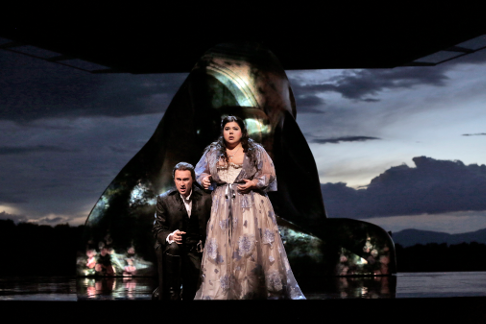 Edgaras Montvidas (Don Ottavio) and Leah Crocetto (Donna Anna)
Edgaras Montvidas (Don Ottavio) and Leah Crocetto (Donna Anna)
But truth to tell, once we are given head at the top of the show, that pretty much sums up the “look.” An exception could arguably be made for the copper bathtub that arises from the trap, to reveal the Don enjoying his bath. That momentary inset also allowed the leading baritone an opportunity to continue his penchant for nonchalant baring of skin. Alas, just as he stepped out of the bath, he was demurely covered by two beach-towel-bearing servants, thereby frustrating many binocular-poised patrons.
Emily Rebholz’s lavish period costumes were very pleasing to look upon, perhaps more pleasing than they were to wear since the men’s attire especially looked cumbersome and a bit earthbound. The women fared better. Kudos are in order for the exceptionally flattering gowns for Donna Anna, effectively imbuing slimming stature and sensuality. The jealousy-green number for Donna Elvira was most telling, and Zerlina’s folk dress was all charming simplicity. The avenging trios’ richly detailed capes lent flowing elegance to the end of Act One.
Significantly, Santa Fe managed to assemble a Dream Team of stars to people its cast for this enduring masterpiece. First among equals, that remarkable artist Kyle Ketelsen proved yet again that he is currently the world’s leading exponent of the scene-stealing Leporello. This is arguably the most richly complicated character in the show, if not the entire Mozart canon, and at this point in his career there is absolutely nothing about the part that eludes him. Mr. Ketelsen has meticulously refined his interpretation through performances of the part in many (Most? All?) of the world’s great houses. Long may he reign.
Kyle’s savvy take on the co-dependent servant has everything a fascinating, exhaustive character study could want. And, even more importantly, he sings it all with a polished, suave bass-baritone that is as gorgeously produced as any in the business. His is a definitive portrayal.
But the opera is not called Leporello, and the charismatic Daniel Okulitch brings all of his familiar skills to bear in the title role. His pleasant, present baritone falls easily on the ear, and his lithe, handsome physique pleases the eye. Mr. Okulitch’s natural stage presence and ample charisma are all decided plusses. Of course, for the story to work we have to believe that everybody and anybody can be lured to have hot monkey love with this debaucher. And believe it, we do.
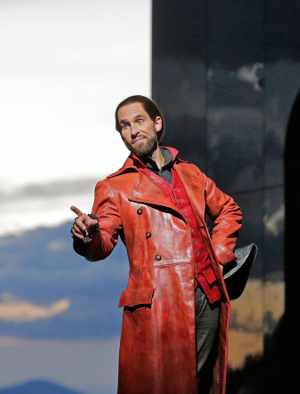 Kyle Ketelsen (Leporello)
Kyle Ketelsen (Leporello)
His challenge is such that he must win over the audience in spite of the almost insurmountable complication of starting the evening, interrupted in mid-rape by a woman’s father, whom he kills! (Oh, that! So much for this being a dramma ‘giocoso.’) To his great credit, Daniel manages to engage us in his well-sung philandering, although I do occasionally wish his pleasant instrument had a bit more heft in the lower range, to impart gravitas and menace.
The prodigiously talented soprano Leah Crocetto offered her best work yet as Donna Anna. Ms. Crocetto has a ravishing spinto sound, to be sure, effortlessly produced. On this occasion, she for once also demonstrated refined dramatic detail. Leah can sometimes be long on creamy tone and short on dramatic intent, but not so here. Her impassioned delivery was compelling, and she could modulate her delivery to encompass both plangent lamentation and resolved conspiracy, with excellent specificity.
Keri Alkema deployed her meaty, zesty soprano to considerably fine effect as a spunky Donna Elvira, potently aggressive when required, but flexible and malleable when so scored. Her fluid coloratura brought real meaning to Mozart’s melismas and her stylish phrasing brought grit and humor to her relentless pursuit of justice. The role of Don Ottavio might have been written for the soaring, honeyed tones of Edgaras Montvidas who overcame the dramatic vapidity of this long-suffering paramour by regaling us with his ravishing lyric tenor in a refined vocal delivery.
As Zerlina, the charming Rhian Lois voiced the role with a slender, delightful, silvery tones of the sort we don’t often hear in a role which has been taken over by heavier sopranos and (even) mezzos in recent years. Ms. Lois’ flawlessly produced soprano and her highly musical singing was a fine complement to the other ladies, and she even made the balance of power far more interesting.
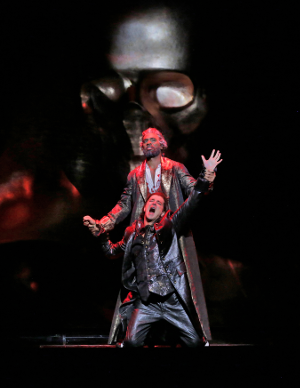 Soloman Howard (Commendatore) and Daniel Okulitch (Don Giovanni)
Soloman Howard (Commendatore) and Daniel Okulitch (Don Giovanni)
Apprentice Artist Jarrett Ott offered a restlessly youthful, winningly voiced Masetto, his smooth, well-schooled baritone a thing of great beauty. Mr. Ott is surely going to find even more dimension in this role as he matures as an artist. Rounding out the cast, young bass-bartione Soloman Howard keeps consistently fulfilling his great promise with a solid, potent performance as a full-voiced, orotund Commendatore.
The top-tier musicians in the pit were led with knowing style by seasoned conductor John Nelson. Some of the tempi were on the slower side, and after a rather languid overture, Maestro Nelson discovered a more deliberate, impelling reading. The skilled orchestra performed conscientiously, exploring rich details with a harmonious accord on Mozartean style.
However, many solo singers tended to drag a few passages (the sterling Mr. Ketelsen always being the exception). For example, the last stretto 6/8 section of La ci darem did not live up to conductor’s correctly heady tempo. Phrase endings tended to broaden, with singers ending out of sync with their skillful band. The accomplished Mr. Nelson is imminently capable of a bit more controlling authority and unity of tempi.
Given the tremendous potential of such a world-class cast, director Ron Daniels sadly discovered little meaningful insight to motivate and inspire this awesome assemblage. Stage movement was functional but hardly innovative, and I had the distinct feeling that the talented ensemble was bringing more of their own experiences with their parts to bear in a staging that was merely competent. The result was more a missed opportunity than the unbridled triumph it might have been.
James Sohre
Cast and production details:
Leporello: Kyle Ketelsen; Donna Anna: Leah Crocetto; Don Giovanni: Daniel Okulitch; Commendatore: Soloman Howard; Don Ottavio: Edgaras Montvidas; Donna Elvira: Keri Alkema; Zerlina: Rhian Lois; Masetto: Jarrett Ott; Conductor: John Nelson; Director: Ron Daniels; Set Design: Riccardo Hernandez; Costume Design: Emily Rebholz; Lighting Design: Marcus Doshi; Projection Design: Peter Nigrini; Choreographer: Nicola Bowie; Fight Directors: Rick Sordelet, Christian Kelly-Sordelet; Chorus Master: Susann Sheston
image=http://www.operatoday.com/7%20Keri%20Alkema%20%28Donna%20Elvira%29%20and%20Daniel%20Okulitch%20%28Don%20Giovanni%29%20in%20%27Don%20Giovanni%27%20%28c%29%20Ken%20Howard%20for%20Santa%20Fe%20Opera%2C%202016.png image_description=Keri Alkema (Donna Elvira) and Daniel Okulitch (Don Giovanni) [Photo © Ken Howard] product=yes product_title=Santa Fe’s Mozart Cast Sweeps All Before It product_by=A review by James Sohre product_id=Above: Keri Alkema (Donna Elvira) and Daniel Okulitch (Don Giovanni)Photos © Ken Howard
Die Liebe der Danae in Salzburg
The dress rehearsal in Salzburg, August 16, 1944, of Richard Strauss' penultimate opera was its premiere and only performance until the 1952 Salzburg Festival (all Third Reich theaters had been closed in late July, 1944). The Covent Garden premiere was in 1953, the Santa Fe Opera American premiere in 1982. In recent years the opera, when attempted, is usually rendered in concert rather than staged.
Thus any new production of Die Liebe der Danae is of great interest — even Salzburg has given it only one other production in the past 65 years! This new production by Latvian stage director Alvis Hermanis imbues the opera with a requisite splendor and conceptual depth that fully complements the surpassing complexities and difficulties of the Strauss score.
Danae, daughter of bankrupt Pollux, has dreamt of gold. If Midas will marry Danae the household will be saved. Three and one half hours later Midas has lost his touch but gained a contented Danae after a monumental tussle with Jupiter who has paid off Pollux's creditors and finally understands that love is more powerful than riches.
All this was actually Strauss' formidable librettist Von Hofmannstahl's idea back in the 1920's who dubbed it a Marriage of Convenience. Not at all in the Roman tradition of Italian comedy, in the spirit of his times Strauss liked to think of his opera as the union of German music and the Greek soul.
 The Grosses Festspielhaus stage with Die Liebe der Danae, Alvis Hermanis designer
The Grosses Festspielhaus stage with Die Liebe der Danae, Alvis Hermanis designer
Director Hermanis worked in bold strokes. The hugely wide stage of the Grosses Festspielhaus was an all white wall and floor, a pyramid of white boxes mounting to a shuttered oblong box. Making the Turkish setting of the Midas myth his backdrop Hermanis mined the riches of Turkish turbans and Oriental carpets. He included Hollywood musicals of the 1930's (Busby Berkeley's Gold Diggers comes to mind), and Islam to boot (the final scene is Midas' harem — 12 women in white burqa contentedly weaving rugs).
Jupiter's harem were 12 Las Vegas style dancers in gold body stockings tirelessly executing sophisticated geometric routines. Hermanis well exploited the talents of Russian choreographer Alla Sigalova who among other jobs is the choreographer for the Russian version of Dancing with the Stars!
Like the Strauss score the staging was spectacular above all else.
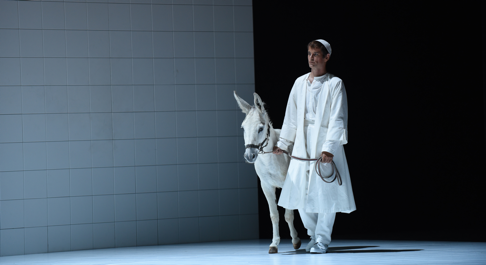 The donkey led by its trainer
The donkey led by its trainer
And the coup de théâtre — the mule of the newly impoverished Midas — a real, alive white donkey led across the elevated open box in the now pristine whiteness of the entire stage! Like Strauss' "love" it was at last something real in this world of riches. It was an almost shocking moment, even moving in the context of the overripe world of Straussian post Romanticism.
Conductor Franz Welser-Möst musically commanded all this most actively plus directing the wondrous splendors of Straussian forces of the Vienna Philharmonic. The grand conductorial traditions of this Von Karajan-designed theater were firmly in place.
Die Liebe der Danae is ultimate Strauss demanding ultimate virtuosity and bravura on all levels, most certainly from the singers. Bulgarian soprano Krassimira Stoyanova negotiated the unrelenting high tessatura of Danae with ease in unflagging golden tone. German tenor Gerhard Siegel, well-known as a Wagner Mime, fulfilled the character demands of the Midas role without fully finding its romantic color, and managed its high tessatura with some difficulties. Polish bass baritone Tomasz Konieczny found both the brashness and the humanity of Jupiter, and delivered his final scene of blessing with utmost elegance. Austrian tenor Norbert Ernst portrayed a dynamic Mercury and Austrian tenor Wolfgang Ablinger-Sperrhacke made Pollux desperate indeed.
Unusual for Strauss were the ensemble scenes — complex machinations of vocal lines managed by a quartet of Pollux' nephews, and a quartet of their wives who are also former conquests of Jupiter. Unusual also was the duet of Danae and her maid, sung by Austrian soprano Regine Hangler, discussing Danaë's dream, the voices weaving equally in and out of the upper ranges.
The star of the show (second performance) was however the donkey who marched center stage and refused to go further. It turned its head to stare directly at the 2400 of us staring back. As any star might it very reluctantly left the stage. Note that its third act entrance was very disciplined.
Michael Milenski
Cast and production details:
Danae: Krassimira Stoyanova; Jupiter: Tomasz Konieczny; Merkur: Norbert Ernst; Pollux: Wolfgang Ablinger-Sperrhacke; Xanthe: Regine Hangler; Midas/Chrysopher: Gerhard Siegel; Four Nephews: Pavel Kolgatin, Andi Früh, Ryan Speedo Green, Jongmin Park: Semele: Maria Celeng; Europa: Olga Bezsmertna; Alkmene: Michaela Selinger; Leda: Jennifer Johnston. Konzertvereinigung Wiener Staatsopernchor; WienerPhilharmoniker. Conductor: Franz Welser-Möst; Stage Direction and Set Design: Alvis Hermanis; Costumes: Juozas Statkevičius; Lights: Gleb Filshtinsky; Video: Ineta Sipunova; Choreography: Alla Sigalova. Grosses Festspielhaus, Salzburg, August 5, 2016.
image=http://www.operatoday.com/Danae_Salzburg1.png
image_description=Krassimira Stoyanova as Danae with dancers. [Photo courtesy of the Salzburger Festspiele, copyright Festspiele / Forster]
product=yes
product_title=Die Liebe der Danae in Salzburg
product_by=A review by Michael Milenski
product_id=Above: Krassimira Stoyanova as Danae with dancers. [All photos courtesy of the Salzburger Festspiele, © Festspiele / Forster]
August 8, 2016
Snape Proms: Bostridge sings Brahms and Schumann
Johannes Brahms was twenty-years-old when he met Clara Schumann, in 1853. She was thirty-four and the wife of his much-loved mentor, Robert Schumann, whom Brahms idolised and desired to emulate. The men shared a sensibility and mind-set in which artistic creativity was fuelled by the symbiotic relationship between love and loneliness; it was a sensibility which infuses their music with a bittersweet animus.
In 1854 Brahms wrote to his friend, the violinist Joseph Joachim: ‘I believe I admire and honour her no more highly than I love and am in love with her. I often have to restrain myself forcibly just from quietly embracing her and even ----: […] I think I can’t love a girl anymore, at least I have entirely forgotten about them; after they promise us the heaven which Clara shows us unlocked’.
Indeed, Clara unlocked not just heaven but artistic vision and resourcefulness. The dialectic between passion and denial, fulfilment and rejection seems almost to be a requisite for Romantic musical fertility. Brahms’s music is a creative contemplation of inner feelings - whether the fire inspired by those feelings was fuelled by passion for Clara, or for the young soprano Agathe von Siebald, whom Brahms met and courted when on vacation in Baden-Baden in 1856 and to whom he gave an engagement ring.
Many listeners and scholars have looked for - and professed to have discovered - a verbal-musical symbolism in Brahms’s music. And, his art-songs might seem to further invite such ‘unlocking’ of meaning as they both directly speak and indirectly embody, in text and music respectively. In this recital of lieder by Brahms and Schumann at Snape Maltings Concert Hall, tenor Ian Bostridge and pianist Julius Drake demonstrated their own shared sensitivity to the way feeling is accentuated by the dualities which both fuel the expressivity and characterise the medium of expression.
Bostridge recently recorded a disc of Brahms’s lieder with Graham Johnson for Hyperion ( Hyperion CDJ33126) but only a few of those songs were included in the selection which formed the first half of the recital. The tenor seemed a little tense at the start of the sequence, but it is a measure of his confidence that the opening song was the technically challenging ‘Es träumte mir’ (I dreamed), the vocal line of which floated on high kept aloft, by Drake’s gently billowing arpeggios. As the poet-narrator drifted into a dream within a dream, Bostridge’s voice was an ethereal thread but one still vivified by the latent energy of awakening. And, with that awakening came the rains and storms of ‘Auf dem Kirchhofe’ (In the church graveyard) in which both voice and piano entered a turbulent darkness, before the stillness of the graves brought some quietude of mind, the lyricism of the final major-key phrases perfectly capturing the peace of the final declaration: ‘Genesen.’ (Released)
After the chill and eeriness of ‘Herbstgefühl’ (Spring feeling), there was an incipient hopefulness in ‘Der Ganz zum Liebchen’ (The journey to love), underscored by the dancing lightness of the piano accompaniment. And, this buoyancy emerged even more strongly in ‘Geheimnis’ (Secret) in which Bostridge conveyed a sense of wonder, through the clarity of tone and diction, and complicity, in the chromatic inflections which tinge the arcing lines of the poet-narrator’s address to the trees: ‘Vertraut ihr das Geheimnis euch/ Von uns’rer Liebe süss?’ (Do you confide to each other, the secret of our sweet love?)
The warm undulations of the piano accompaniment to ‘Minnelied’ (Lyric love song) blessed the song with a welcome richness while Bostridge’s articulation of the final verse exemplified his sensitivity to Romantic sensibility and to the German language: the melodic crest, ‘Traute, minnigliche Frau’ (Gentle, charming lady), bloomed affectionately before the tenor retreated, softly emphasising the final line, ‘Mög’ in Wonne blühen’, daring to hope that his heart might ‘bloom in bliss’ like the sunset reddening meadow.
Drake’s accompaniments were inextricably fused with the vocal expression. The unstable modulations at the end of the second verse of ‘Alte Liebe’ (Old age), and the diminished harmonies which underscore the opening of the third were wonderfully expressive of what one scholar has called Brahms’s ‘masochistic nostalgia’, as the poet-speaker ponders, ‘Es ist, als ob mich leise/ Wer auf die Schulter schlug’ (It is as if someone tapped me on the shoulder). And, the piano postlude confirmed and enhanced the compulsion, derived from sadness and acceptance, which is expressed in Bostridge’s final phrase, ‘Ein alter Traum erfaßt mich/ Und fürht mich seine Bahn.’ (An old dream takes hold of me and leads me on its path) The entwining cascades of ‘Sommerfäden’ (Threads of summer) embodied both the exterior world - the gossamer threads of summer light which the poet-singer imagines as a tapestry of ‘Liebesträume’ (dreams of love) - and a dark interiority, as he sees his own fate hanging by such a brittle thread. Similarly, the spirals which surged from the depths in ‘Verzagen’ (Despair) were both the raging storm-sea and the poet’s lurching heart in love-sickness.
In the final sequence of three songs, the poet-narrator increasingly embraced the loneliness of reminiscence. ‘Über die Heide’ was an eerie lament for life and love, which have flown by and taken with them the certainty that rapture ever existed. ‘Mein Herz ist schwer’ (My heart is heavy) stepped deeper into melancholy; the anger beneath the poet-singer’s dejection was evident in the vigour with which Bostridge and Drake imbued the tugging cross-rhythms of the sighing wind in the final verse, when the poet broods over just where grief, love, joy and youth have fled - ‘Mein Herz ist schwer, mein Auge wacht’ (My heart is heavy, my eyes keep watch). ‘Botschat’ (Message) had a calmer lilt and Bostridge shaped the unusual intervals of the vocal line into beguiling curves, withdrawing to a tender murmur for the young man’s entreaty to the breeze to encourage his beloved to salve her lover’s sorrow with hope: ‘Denn du, Holde, denkst an ihn.’ (For you, fair one, think of him)
Schumann’s bitter-sweetness has a sharper, more biting tang. After the interval, Bostridge’s penetrating insight brought the protagonist of the composer’s settings of Heine vividly to life, or perhaps one ought to call it death-in-life, such is the melancholic jouissance of Heine’s texts.
The Romantics’ ambiguous blend of life and languor, desire and dejection was tensely present from the first song, ‘Dein Angesicht’ (Your face), and deepened in ‘Lehn’ deine Wang’ (Against my cheek); but, the urgency of close-pressed hearts and the flowing river of the lovers’ tears dissolved in the second stanza as, clasping his beloved in his arms, the poet-narrator dies of love’s desire, bringing about a relaxation which allowed Bostridge to embrace the song’s prepubescent, heightened lovesickness: a mercurial blend of hope, naivety and pain.
Drake was a superb accompanist, as alert as Bostridge to every nuance of the Romantic cast of mind which the songs embody - and equally equipped with the technique and artistry to craft those nuances into a unity which is both coherent and contradictory. The ‘dark splendour’ of the piano tone showcased the bright gleam of the singer’s flowering adoration in ‘Es leuchtet meine Liebe’, while the stature of the chordal postlude confirmed the inescapable tragedy of the gloomy folk-tale of love. In ‘Mein Wagen rollet langsam’ the tight, dotted rhythms of the rolling carriage alternated with a tender chord sequence, as the charms of nature lulled the poet-speaker into a seductively solipsistic dream; but, Bostridge’s murmured will-o’-the-wisps - who ‘hop and pull faces,/ So mocking yet so shy’ (‘Sie hüpfen und schneiden Gesichter,/ So spöttisch und doch so scheu’ - took on an ominous tone as the goblins whirled together like mist.
The programme originally placed Schumann before Brahms, but that the decision to reverse the composers in a-chronological sequence was the right one was confirmed by the profound artistry of the interpretation of Dichterliebe Op.48 with which the recital concluded.
Bostridge recorded the cycle with Drake in 1998 ( EMI Classics - 5 56575 2 ). Of course, every time a singer presents a song, or cycle, it will be a new performance, shaped by both preparation and spontaneity. But, it seemed to me that this Dichterliebe was more introspective than previous accounts, live and recorded, that I have heard from Bostridge: the haunting poeticism and anguish more prolonged and deep. And, that this quality was underpinned by a core strength in the voice which enables the singer to phrase the melodic line with ever more control. The gentlest of vocal caresses - as the poet-singer bathes his soul in the lily’s chalice in ‘Ich will meine Seele tauchen’, or the dreamed beloved whispers soft words to the sleeping poet in ‘Allnächtlich in Träume’ - can retreat into coaxing softness but still retain an underlying presence. Angry or impassioned outbursts - the wild rush of pain which bursts the lover’s heart in ‘Hör’ ich das Liedchen klingen’ (When I hear the little song), or the bloom of burgeoning love in ‘Im wunderschönen Monat Mai’ (In the wondrous month of May), or the snarling rage at the heaviness of sorrow in ‘Die alten, bösen Lieder’ (The bad old songs) - make their impact, sometimes stirring, sometimes shocking, through subtle enrichment without overly emphatic contrast of timbre.
Drake found an elegiac poeticism in the piano’s opening signature statement, the rippling cascades which commence ‘Im wunderschönen Monat Mai’, and which are restated and varied through the cycle, seeming to anticipate the fragile pathos of Brahms’s Intermezzo in B minor Op.119. The rubatos were pronounced but not mannered, and this drawing out of the line was a feature of the whole cycle. For example, after the blissful energy of ‘Die Rose, die Lilie, die Taube, die Sonne’ (Rose, lily, dove, sun), the confidence of the first stanza of ‘Wenn ich in deine Augen see’’ - in which Bostridge gave sustained strength to the declaration, ‘So werd’ ich ganz und gar gesund’ (Then I am wholly healed) - gave way to a desperate need for assurance to combat doubt, expressed through slow deliberation: ‘Doch wenn du sprichst: ich liebe dich!/ So muss ich weinen bitterlich.’ (But when you say: I love you! I must weep bitter tears.)
There was a weariness underlying this cycle as Bostridge’s protagonist sometimes withdrew into introspective rumination. The concluding statement of ‘Ich grolle nicht’ - ‘Ich sah, mein Lieb, wie sehr du elend bist. Ich grolle nicht.’ (I saw, my love, how pitiful you are. I bear no grudge.) - was resignedly dismissive rather than cynical. The walker in the garden in ‘Am leuchtenden Sommermorgen’ (One bright summer morning) seemed drained and disenchanted, the slow pace and piano rubato suggesting a disengagement from the whispering flowers which here offered a piteous plea: ‘“Sei unsrer Schwester nicht böse, Du trauriger, blasser Mann.”’ (‘Be not angry with our sister, You sad, pale man.’)
Yet, paradoxically there was a driving force which connected the sequence of songs, the ending and beginning of consecutive songs fused as if part of an unstoppable continuum of emotion. After the ponderous, dragging articulation of the piano’s dotted rhythms at the start of ‘Im Rhein, im heiligen Strome’ (In the Rhine, in the holy river), at the close Drake’s jerky, angrily hammered bass line was still ringing when he began ‘Ich grolle nicht’, and the subsequent ‘Und wüssten’s die Blumen, die kleinen’ (If the little flowers knew) followed segue. Dreams and awakenings alternated until it was impossible to know the imagined from the real.
Bostridge appeared to feel every emotion as if it were his own, as if the words sprang from his own wrenched and troubled heart. As he immersed himself in the verbo-musical discourse he become deeply introspective. And, much of the affective intensity of his performance derives from this ability to understand what lies within the music; it is a gift that Drake shares - the capacity to articulate the inner voice hidden within the music. Yet, I wondered if sometimes Bostridge did not drift too far into an interior world, remote from the listeners in the Maltings Hall. Frequently, he stared intently at an unseen horizon, or down as if some resolution to the pains of life might be found deep in the bowels of the earth; or even, within the body of Drake’s Steinway, as he offered the audience a bowed profile.
During a conversation (interview), baritone Mark Stone spoke to me of the way audiences have to work hard to understand and enjoy a song: they have to listen intently to a text, perhaps in a language not their own, and can’t just sit back and let the music ‘wash over’ them. Stone suggested that they can feel as much a part of the performance as the singer; and that the singer may even feel that he or she is forming an individual relationship with each listener - one that must be sustained, not just through musical expression but also through eye contact.
Of course, the Maltings Hall is a large venue for a lieder recital and this sort of direct communication between individuals may not be possible or desirable. And, all artists have a manner in performance which is natural to them. There is no doubt that Bostridge’s experience, expressed through his stage demeanour, is intense and honest. And, as a self-confessed Bostridge ‘aficionado’ I would not desire him to perform in any other way. But, I did find myself on occasion during this recital longing to see Bostridge really sing out to us, rather than inwards. On those occasions when the tenor directed his gaze at his listeners - when he let us into the secret of his broken heart in ‘Und wüssten’s die Blumen, die kleinen’, or as his hopes rose of reaching the magic landscapes of ‘Aus alten Märchen’ (From fairy-tales of old) and attaining freedom from pain - the result was a frisson of energy and engagement.
After all Schumann, Brahms and all those Romantic dreamers acquiesce in their loneliness. It is as essential as love. As Shakespeare tells us in All’s Well That Ends Well, ‘The web of our life is of a mingled yarn, good and ill together:/ our virtues would be proud if our faults whipped them not;/ and our crimes would despair if they were not cherished by our own virtues.’ (IV.iii.84)
Clearly drained at the close of the recital, Bostridge accepted the applause with characteristic sombreness and reserve. I just hope that he enjoyed singing these songs as much as we enjoyed listening to them.
Claire Seymour
Ian Bostridge (tenor), Julius Drake (piano).
Brahms: ‘Es träumte mir’ Op.57 No.3, ‘Auf dem Kirchhofe’ Op.105 No.4, ‘Herbstgefühl’ Op.48 No.7, ‘Der Gang zum Liebchen’ Op.48 No.1, ‘Geheimnis’ Op.71 No.3, ‘Minnelied’ Op.71 No.5, ‘Alte Liebe’ Op.72 No.1, ‘Sommerfäden’ Op.72 No.2, ‘O kühler Wald’ Op.72 No.3, ‘Verzagen’ Op.72 No.4, ‘Uber die Heide’ Op.86 No.4, ‘Mein Herz ist schwer’ Op.94 No.3, ‘Botschaft’ Op.47 No.1; Schumann: (Lieder on texts of Heine) ‘Dein Angesicht’ Op.127 No.2, ‘Lehn deine Wang’ Op.142 No.2, ‘Es leuchtet meine Liebe Op.127 No.3, ‘Mein Wagen rollet langsam’ Op.142 No.4, Dichterliebe Op.48.
Snape Maltings Concert Hall, Snape; Saturday 6th August 2016.
image=http://www.operatoday.com/Bostridge.png image_description=Snape Proms, 6 August 2016 product=yes product_title=Snape Proms, 6 August 2016 product_by=A review by Claire Seymour product_id=Above: Ian BostridgeAugust 5, 2016
Cosi fan tutte in Salzburg
Unlike Le nozze di Figaro (2014) and Don Giovanni (2015) both staged by Mr. Bechtolf in the Haus für Mozart theater (both to be revived later in the month) Cosi is staged in the Felsenreitschule — the old riding school with galleries carved into Salzburg's famous city center rock.
Thus director Bechtolf's staging is site specific, utilizing the 50 or so meter wide (165 feet or more), three tiered carved into the stone galleries as a living backdrop (singers and supers move amongst the tiers) the equally wide stage platform as a field for a sort of improvised street theater style staging. During the overture a number of black cloaked, masked sort of ninjas use chloroform saturated handkerchiefs to lay out Fiordilig and Dorabella (left supine on the stage) and Despina (carted off on a wheelbarrow).
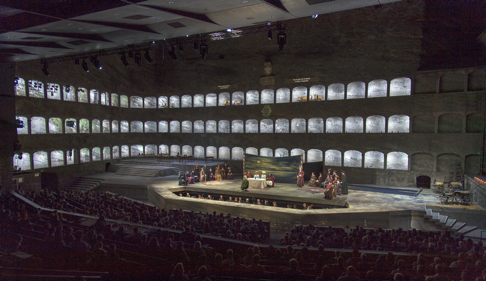 The Felsenreitschule galleries and Cosi stage platform
The Felsenreitschule galleries and Cosi stage platform
The knocked out sisters are draped onto a sofa (that needless to say will seat four at strategic moments), Don Alfonso, Ferrando and Guglielmo make their wager, The ninjas retreat to some sort of library way over on stage right. And the geometry (symmetries of four or six points) begins, and so far so good.
A pit has been cut into the stage platform in which the Mozarteum Orchester Salzburg was seated that provided polished (what else) accompaniment for the next four hours, its winds in pure sounds that evoked an orchestral utopia from another time within the splendid acoustic of this architectural artifact.
The conductor for the Cosi in this cycle is Ottavio Dantone (Dan Ettinger conducts Le nozze, Alain Altinoglu conducts the Giovanni). Mo. Dantone, a gifted Italian early music specialist, provided measured tempos throughout the evening allowing the Da Ponte text to be deliberately stated, tempos that were musical rather than dramatic. It was a lyric evening indeed with nothing musically extraordinary expected of the artists beyond fine singing.
The sisters Fiordiligi and Dorabella, sung by German soprano Julia Kleiter and American mezzo soprano Angela Brower respectively, were identically costumed in period style (only a slight variation of pastel hue) and vocally and musically perfectly matched in their pure rather than rich tones. Fernando, Swiss tenor Mauro Peter (a noted lieder singer) who with Guglielmo, Italian bass baritone Alessio Arduini, did their best to execute the fairly tame antics imposed on the young soldiers by director Bechtoff. Interestingly both Don Alfonso, sung by German bass-baritone Michael Volle and Despina, sung by Swiss soprano Martina Janková were aggressively presented, irritants to the protagonists rather than the amused instigators of Da Ponte's dirty trick.
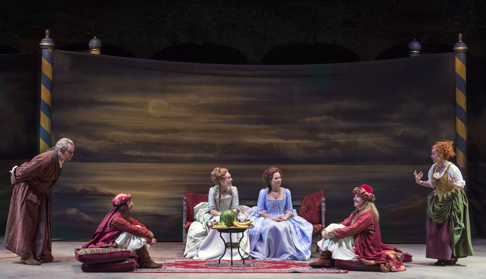 Left to right: Don Alfonso, Guglielmo, Dorabella, Fiordiligi, Ferrando, Despina
Left to right: Don Alfonso, Guglielmo, Dorabella, Fiordiligi, Ferrando, Despina
Director Bechtolf's humor is low key in simple, momentary situational comedic skits that precluded a larger dramatic focus. Notably "Come scoglio" — Fiordiligi holds the entire cast at sword point for the duration of the aria, some traversing the runway that created a fore-stage in front of the pit (and therefore illustrating a theatrical chic fourth wall). On the other hand the trio "Soave sia il vento" was sung entirely presentational, the three singers seated unmoving on the sofa.
Musically the high point of the evening was the quartet of leave taking, the sisters bidding farewell to their soldier lovers. It was delivered with the musical precision and mannered shaping of exquisite string quartet playing.
Our expectations for an exceptional evening were high indeed.
The evening did not sustain this level of studied musical and theatrical interest. In the best of times the second act of Cosi challenges the stamina of is audience. Here the alternation of comedic moments with presentational scenes of serious feeling lost momentum. The emotional scope of the singers proved limited, and the directorial attempt to create interest by referencing the geographical extremes of the stage platform and by populating the back wall galleries succeeded only in pulling focus from the tense Fiordiligi Ferrando situation center stage.
Finally this difficult dramaturgical problem was more or less dismissed both musically and theatrically. At the end the four protagonists dashed individually to the four separate corners of the platform, the tyranny of all this theatrical geometry destroyed. Or something.
Michael Milenski
Production information:
Chorus: Concert Association of the Vienna State Opera Chorus; Orchestra: Salzburg Mozarteum Orchestra. Conductor: Ottavio Dantone; Stage direction and set design: Sven-Eric Bechtolf; Costumes: Mark Bouman; Lighting: Friedrich Rom. Felsenreitschule, Salzburg, August 2, 2016.
image=http://www.operatoday.com/Cosi_Salzburg1.png
product=yes
product_title=Cosi fan tutte in Salzburg
product_by=A review by Michael Milenski
product_id=Above: Da Ponte's four young lovers in the Riding School [Photo by Monica Rittershaus, courtesy of the Salzburger Festspiele]
The Exterminating Angel in Salzburg
The opera is the film recast for Salzburg, Covent Garden and the Met by Adès and British stage director Tom Cairns. For Buñuel the film was gentle if macabre, humorous if macabre condemnation of Spain's Fascist bourgeoisie.
Re-worked in Salzburg the exterminating angel (an invisible presence) presides at a dinner party after an opera where its conductor's wife amuses with a (brief) piano recital and its diva is begged to sing a song by Adès. By mutual consent and compulsion no one can leave the party — for days, then weeks. Feelings fray, living conditions deteriorate. Finally the guests agree the only possible exit is to sacrifice the host. The diva has the revelation that they all now are exactly where they initially were. They leave.
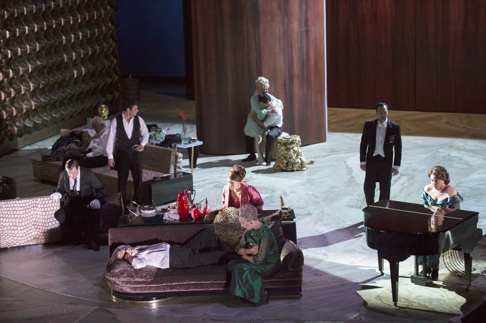 The piano recital
The piano recital
And they will be back. Like, just like the Salzburg audience. Year after year.
Adès opera is bourgeois, hook, line and sinker. Rich, beautiful music requiring everything money can buy, i.e. triple winds, huge percussion battery. Difficult music requiring extended rehearsals for orchestra and for twenty-two solo voices plus chorus and dancers. It is an undertaking only possible at institutions lavishly supported by the haute bourgeoisie. The three mentioned above are possibly the only such in existence. The ironies are blatant.
Adès inspiration is obviously complex, and finally he surely is teasing himself. And delighting in composing music that has the depth and breadth to encompass a quarrel about the size of spoon needed to stir coffee and the lengthy death of an elderly guest and then an intense love death, not to mention slaughtering a couple of lambs to avoid starvation, the cuisson of which is a lengthy discussion. The piano becomes more and more distressed, a cello is smashed, incest revealed.
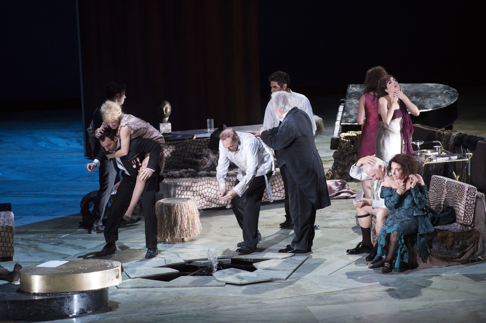 The excavation to access water
The excavation to access water
It is rich, beautiful music that can say anything, the sublime merged with the twisted, the simple with the complex. Music of Wagnerian scope and Brittenesque precision, of Buñuelian cruelty and Aristophanesque satire. It is pure Thomas Adès.
Adès somehow creates natural sounding vocal lines in surreal intervals and rhythms that explore surreal vocal ranges. The always forte orchestral score exposes extreme unidentifiable harmonies that, like Messiaen, grandly pass over or sometimes converge on beautifully inverted triads. Orchestral climaxes are sometimes hugely violent, explosive if impotent energy released. It is gratifying, very pleasurable music in service to supercilious philosophy.
As expected in Salzburg casting was exemplary, of particular note the huge vocal presence of the dinner's hostess Lucis de Nobile sung by South African soprano Amanda Echalaz, plus the freakishly high voice of American soprano Audrey Luna who squeals and squeaks the role of the opera diva Leticia. Swedish mezzo-soprano Anne Sofie von Otter sang Leonora's moving delirium and lovely if occasionally putrid prayer to the Virgin Mary. British tenor Ed Lyon and British soprano Sophie Bevan grandly intoned the love death.
The staging conceived by director Tom Cairns was adequate but not complimentary to the score, the bows (no solo bows) were excessively choreographed.
Michael Milenski
Cast and production details:
Performers: Amanda Echalaz, Audrey Luna, Anne Sofie von Otter, Sally Matthews, Christine Rice, Sophie Bevan, Charles Workman, Frédéric Antoun, David Adam Moore, Iestyn Davies, Ed Lyon, Sten Byriel, Thomas Allen, John Tomlinson, Morgan Moody, John Irvin, Franz Gürtelschmied, Rafael Fingerlos, Frances Pappas, Anna Maria Dur, Cheyne Davidson, Leonhard Radauer, Elias Karl. Sfalzburger Bachchor, ORF Radio-Symphonieorchester Wien. Conductor: Thomas Adès; Stage Director: Tom Cairns; Sets and Costumes: Hildegard Bechtler; Lighting: Jon Clark. Haus für Mozart, Salzburg, August 1, 2016.
image=http://www.operatoday.com/Angel_Salzburg1.png product=yes product_title=The Exterminating Angel product_by=A review by Michael Milenski product_id=Above: At left Amanda Echalaz as Lucia de Nobile and Charles Workman as Edmundo de Nobile with guests emerging from self imposed captivity. [All photos courtesy of the Salzburger Festspiele, copyright Ruth Walz}August 4, 2016
The Queen of Spades, Opera Holland Park
Rodula Gaitanou’s production tells the story well, and offers some probing beneath the surface - although not so much when contrasted with reports of Stefan Herheim’s recent staging in Amsterdam. (By the same token, however, OHP does a great deal with more limited resources; it would in any case be unreasonable or downright absurd to expect every opera production to be an event on the level of a Herheim production.) I did wonder whether the sight of two men beneath an arch in the penultimate scene was intended as an oblique reference to Tchaikovsky’s homosexuality, but, given the darkness, it was a bit difficult to tell. Perhaps that is the point. There is, in the late-nineteenth-century updating - time of composition, I presume - some sense of pitting a self-consciously beautiful society against more human desires, noble and base alike. Cordelia Chisholm’s designs will certainly delight those who wish to see ‘traditional’ productions, doubtless ignoring the fact that the opera is not set when it ‘should’ be.
The Countess seems to rule the roost in a fashion beyond what one might expect; this is, perhaps, an ageing society, unable to accept the need to change. If I felt that some of those points might have been pushed a little harder, there is something to be said for not doing so either. We all have particular tastes, and have no right to insist that everything should be as we should have done it; indeed, we should be willing to learn from things done differently - and done well. I found that, on reflection, the production had more to offer than I had initially thought; there is certainly much to be said for relative subtlety. (Just as there is much to be said, from time to time, for agitprop!)
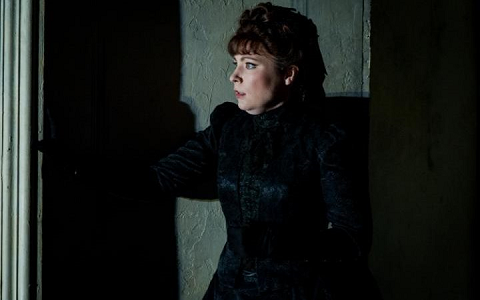 Natalya Romaniw as Lisa in The Queen of Spades at Opera Holland Park. Photo credit: Robert Workman.
Natalya Romaniw as Lisa in The Queen of Spades at Opera Holland Park. Photo credit: Robert Workman.
It was, perhaps inevitably, Rosalind Plowright’s Countess who made the strongest dramatic impression. Although she does not have very much to sing during the first act - here, Tchaikovsky’s three acts were condensed into two - she held the stage just by entering, let alone by painfully, agonisingly, walking across it with her sticks. (I thought a little of my first encounter with Waltraud Meier in the theatre: as Ortrud as Covent Garden. The character has little to sing at all in the first act of Lohengrin, but I could not keep my eyes off her.) And the insight into her interior life, above all to her past, was moving, evoking an historical canvas far wider than we were explicitly or even implicitly told. Natalya Romaniw did not disappoint as Lisa, although I felt that her character came more into its own following the interval; a freer, more daring performance to be seen and heard. Again, perhaps that was the point. Peter Wedd’s Herman was, I am afraid, harder to like. The character seemed less impetuous than annoying, somewhat generalised, even wooden acting meaning that it was difficult to feel much chemistry between him and his beloved. As melodrama there was something to be said for such a performance, but there was much that it lacked; a fine vocal performance might have compensated, but that was not to be either. Grant Doyle’s Yeletsky, however, was very fine indeed: darkly conflicted, and beguiling of line.
Other, ‘smaller’ roles were all taken well, Richard Burkhard’s Tomsky, Daisy Brown’s Masha, and Laura Zigmantaite’s Governess particularly catching my ear - without that reflecting negatively upon any of the other singers. It was the Opera Holland Park Chorus, though, which so often stole the show. Expertly trained, not just musically but in its Russian too (insofar as I could tell!), by Philip Voldman, and responding well to detailed direction, choreography (Jamie Neale) included, the chorus members performed equally well as individuals (highly impressive waiters, for instance, in the first scene) and corporately. We shall doubtless see and hear more from many of them.
Ideally, we should have heard a larger orchestra than the Holland Park pit can accommodate. There were certainly times when the lack of a greater body of strings detracted from Tchaikovsky’s Romanticism. However, there is a good deal of (neo-)Classicism to the score too; that often thrived under Peter Robinson’s direction. The Mozart pastiche music - which, of course, never quite sounds like Mozart, but gives us a good idea of Tchaikovsky’s limited understanding of Mozart - came off particularly well, but so did the obsessive qualities of the score. The City of London Sinfonia woodwind were on particularly good form, and the strings performed creditably indeed, given their limitation in number. Opera Holland Park’s productions tend to evoke above all a splendid sense of company, of an evening that is considerably more than the sum of its parts; this was no exception.
Mark Berry
Peter Ilyich Tchaikovsky, The Queen of Spades
Herman: Peter Wedd; Lisa: Natalya Romaniw; Countess: Rosalind Plowright; Count Tomsky: Richard Burkhard; Prince Yeletsky: Grant Doyle; Polina: Laura Woods; Masha: Daisy Brown; Chekalinsky: Aled Hall; Surin: Simon Wilding; Governess; Laura Zigmantaite; Chaplitsky: Oliver Brignall; Narumov: Henry Grant Kerswell; Master of Ceremonies: Timothy Langston. Director: Rodula Gaitanou; Designs: Cordelia Chisholm; Lighting: Simon Corder; Choreography: Jamie Neale. Opera Holland Park Chorus (chorus master: Philip Voldman)/City of London Sinfonia/Peter Robinson (conductor). Holland Park, London, Tuesday 2 August 2016
image=http://www.operatoday.com/eter%20Wedd%20%28Herman%2C%20left%29%20and%20Rosalind%20Plowright%20%28the%20Countess%29%20Robert%20Workman.png image_description=Opera Holland Park, The Queen of Spades product=yes product_title= Opera Holland Park, The Queen of Spades product_by=A review by Mark Berry product_id=Above: Peter Wedd (Herman, left) and Rosalind Plowright (the Countess)Photo credit: Robert Workman
Prom 25: the dark, soulful realms of Bluebeard and Dvořák
Alban Gerhardt chose to reveal a different Concerto - one that is introspective, tender and haunting, and whose passion is communicated through concentration rather than through overt virtuosity and spontaneity. It was a performance which demanded listeners’ unwavering attention: a brave demand in the cavernous Royal Albert Hall which does not provide a sympathetic acoustic for solo cellists. Indeed, it was a performance which threw a challenge to the accompanying Royal Philharmonic Orchestra too: I’m playing quietly, so you’ll have to pipe down if you want to hear me!
But, despite its reflective mood, Gerhardt’s rendition was anything but underwhelming; indeed it was so absorbing that it made imagine one was in a much more intimate environment. If we had to lean in and focus intently to hear the quietest passages we were rewarded by playing of exquisite refinement, as the cellist seemed to seek something intangible in Dvořák’s score, reaching deep beneath the surface. Not for Gerhardt heart-on-sleeve emotion or vigorous attack; rather, the pensiveness of a German lied, delivered with control and eloquence, supported by a flawless technique. He took great care to shine a light on the details, finding clarity and precision at the top and bottom of the range.
The Adagio ma non troppo was the heart of the performance. Infused with the composer’s love for Josefína Čermáková - his passion was never reciprocated and Dvořák married her sister, Anna - and with the melodies of Josefína’s favourite song, Dvořák’s own Op.82 No.1 ‘Lasst mich allein’ (Leave Me Alone), the second movement was dignified by sadness; simplicity rather than showmanship was the touchstone. Gerhardt seemed to be thinking like a singer. From the first phrase the moulding of the song was beautiful, blending melodiously with the low oboe. The tempo flowed with a strong sense of the architecture of the whole movement.
Charles Dutoit and the Royal Philharmonic Orchestra did not always seem to be on completely the same wave-length as their soloist. The first movement begins with a long orchestral introduction and this was rather tentative and lacking in warmth. Solos from the horn and clarinet were accurate but could have had more life - enriched as they are by the energetic patriotism of the composer’s love for his homeland.
Dutoit set out to match his soloist’s delicacy of approach but the RPO needed firmer guidance, for the results were cautious. It’s a long wait for the soloist, but with his first tonally vibrant entry Gerhardt took command and established a more intense focus and direction: the opening note had such presence, as if he was declaring, ‘This is my concerto now …’
Technically Gerhardt was untroubled. In the first movement, the rapid spiccato flew, dense chords progressed fluidly and there was a sense of urgency, especially when the cellist reached to the top of the A string. In the second-movement cadenza Gerhardt drew out the double-stopping and swiftly executed the left-hand pizzicato, building to an exciting stringendo, characterised by lovely dialogues with the woodwind and some particularly fine clarinet-playing.
Despite the spaciousness of Gerhardt’s interpretation, the momentum never flagged; in fact, the cellist seemed to want to push forward, and was often a fraction ahead of Dutoit and the RPO, meaning that the cadences to the climactic passages perennially put the brakes on. This was particularly noticeable in the third movement, where the first entry of cello ratcheted up the pace by the slightest of notches. I felt that Gerhardt wanted a tenser beat, not necessarily much faster but with more crispness. Some of Dutoit’s rallentandos and rubatos lessened the impetus.
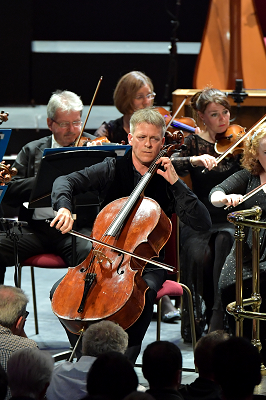 Alban Gerhardt. Photo Credit: Chris Christodoulou.
Alban Gerhardt. Photo Credit: Chris Christodoulou.
The accompaniment might have been tauter with more emphasis given to both the lyrical nuances and the Bohemian energy of the rhythms, but this was a solo performance characterised by mastery and civility. Both of these qualities imbued the encore - Gerhardt’s professed favourite among Bach’s solo suites, the Prelude of the D major Suite BWV1012 - with potent expressivity.
Gerhardt must be approaching nearly 200 performances of Dvořák’s Concerto; in a programme-booklet interview Hungarian mezzo-soprano Ildikó Komlósi tells us that she has sung the role of Judith in Bartók’s Duke Bluebeard’s Castle more than 150 times, but there was no lacking in freshness or incisiveness in her performance, with bass John Relyea as the eponymous menacing anti-hero. If Gerhardt took us on a journey to Dvořák’s Bohemian heart then in this dramatically compelling musical narration the Royal Philharmonic Orchestra and Charles Dutoit searched deep inside Bluebeard’s soul, penetrating to the depths and finding as much sadness amid the darkness.
In the spoken Bard’s Prologue Relyea declaimed in a lovely speaking voice, inviting the listener in, ‘How shall I tell the story?’ There were hints of the resounding bass that would challenge us later - the command to ‘Listen and marvel/ladies and gentleman!’ was uttered quietly and low, followed by a salient pause. The slow ponderousness of ‘Old is the castle, and old the tale that tells of it’ had an innately ominous weight: it placed the burden on our own interpretation - ‘Listen in silence’.
There was a sombreness in Relyea’s sensitive delivery from the opening phrases as he showed his new bride his castle, ‘Not a cheery place like your father’s’, which were countered by the expectant brightness of Judith’s optimism, yet confirmed by the dark foreboding of the orchestral timbre.
Such dualities characterised Relyea’s Bluebeard; he was both satanic and sentimental. At times, the voice was reticent conveying a genuine, and touching, pathos and pain. Utterances had sincerity: ‘Your sweet hands are blessed, Judith’, he declares, when she asks for the keys to his locked rooms. But, Relyea could turn from softness to iron. When tells her to be careful, ‘Go with breathless caution’, the controlled vibrato and penetrating warmth betrayed true feeling; but, this was swept aside by a harder tone when she views his armoury, enhanced by the military brightness of the RPO. Then, Bluebeard utters a desperate pathos of sigh, ‘Judith, Judith’, when she demands the keys to the remaining doors: who could not be touched by this sob from the soul, especially when the beautiful plangent string playing drew every ounce from Bartok’s heart-tugging harmonies.
Relyea’s upper register retained heroic attractiveness and virility, but this was mingled with desperation: Bluebeard calls to his doomed bride before the last two doors are opened, ‘Judith, Judith, I must kiss you’, and the subsequent orchestral glissandi slithers showed the hopelessness of resisting his tragic destiny, ‘Judith, Judith, do not open!’
My ability to comment on the Hungarian diction is negligible, but following the libretto I couldn’t detect any significant difference between the two singers. Bluebeard’s dreadful sigh when tells her that behind the sixth door are ‘Tears, my Judith, tears, tears’ was a heart-pummelling throb in the throat. But there remained defiance; Relyea flung his cries of ‘Take it, Take it’ to the violent thumps and tempestuous whirls of orchestra as Judith opened the last door, but his strength dissipated into a terrible vulnerability as he revealed the ‘Hearts that I have loved and cherised’. Relyea’s performance was Shakespearean in its tragic depth; like Lear he remained defiant - his dead wives will ‘live immortal - All is theirs now, all my treasure’. Such dignity was painfully bold.
Komlósi’s used her fantastic chest register to delineate Judith’s vitality, sensuousness and hopefulness; even when assailed by blood on the castles walls, the veiling of her vibrancy was short-lived and shallow as she declared that she longer craved ‘daylight/ Roses, sunshine, they are nothing’. There was a horribly portentous gleam to Judith’s ecstatic cry that they are ‘All in darkness’ and real vitality to her conviction that ‘I shall breach these ramparts. … Bright as gold your house shall glitter’.
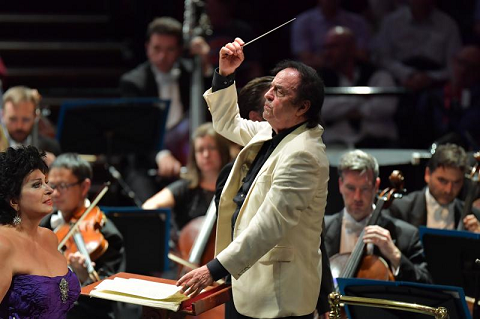 Ildikó Komlósi with Charles Dutoit. Photo Credit: Chris Christodoulou.
Ildikó Komlósi with Charles Dutoit. Photo Credit: Chris Christodoulou.
Komlósi used quite a wide vibrato to make the voice carry at the top and the tuning went a bit wayward at times. But, in the middle of her voice there was a teasing voluptuousness to the sound: one could see what had attracted Bluebeard. Yet, this was coupled with a convincing naivety; even after the fifth door had been opened, she could credulously ask, ‘What are these grim clouds portending?’ There was great poignancy at the opening of sixth door, and if Komlósi tired towards the close, this was not out of keeping with Judith’s emotional exhaustion and defeat.
Dutoit and the RPO were superlative storytellers. The orchestral crescendos and sforzandi had a vicious bite, while still being tonally beautiful. The orchestral barrages were violent, and the sparse textures were pointed and perfectly tuned. Woodwind scurries and percussive batteries were hard-edged and incisive; the brass explosions and snarling dissonances made one tingle.
Dutoit conjured a transparency which made every gesture tell. The sustained trumpets, solo violins and descending horns painted a shimmering ‘mountains of gold’ which was menacingly marred by flute and oboe dissonances. The dolce sweetness of the verdure which rests behind door four was given presence by the restful horn solo, as sunshine shone on the flower-laden branches in the blue-green garden. And, there is no visual image that could match the impact of the horrible grandeur which lies behind the fifth door: as full orchestra and organ move through thrilling sequences of parallel chords, in blazing defiance, every nerve-ending in the RAH must have shuddered.
In contrast, clarinet and horn conjured the poignant lake of tears beyond the sixth door; slithering shivers of harp, clarinet and flute against a dark bass outline made the spine tingle, eased by the sensuousness of Judith’s disavowing request that her lord ‘take me, love me’ after seeing the lake of tears. There was a terrible renewed energy in the chromatic climbing lines when Judith has ‘guessed his secret’.
This was a fantastically captivating orchestral narrative; even though we know the protagonists’ fate there was tension, fear and hope. Dutoit never let the moments of pathos linger, but swept them up in the inexorable tragic path.
Claire Seymour
Dvořák: Cello Concerto in B minor Op.104
Bartók: Duke Bluebeard’s Castle Sz48 Op.11
Alban Gerhardt (cello), Ildikó Komlósi (soprano), John Relyea (bass), Royal Philharmonic Orchestra/Charles Dutoit (conductor), Royal Albert Hall, London, 3 rd August 2016.
image=http://www.operatoday.com/Relyea.png image_description=Prom 25: Duke Bluebeard's Castle, Dutoit and the RPO product=yes product_title= Prom 25: Duke Bluebeard's Castle, Dutoit and the RPO product_by=A review by Claire Seymour product_id=Above: John Relyea as BluebeardPhoto credit: Chris Christodoulou